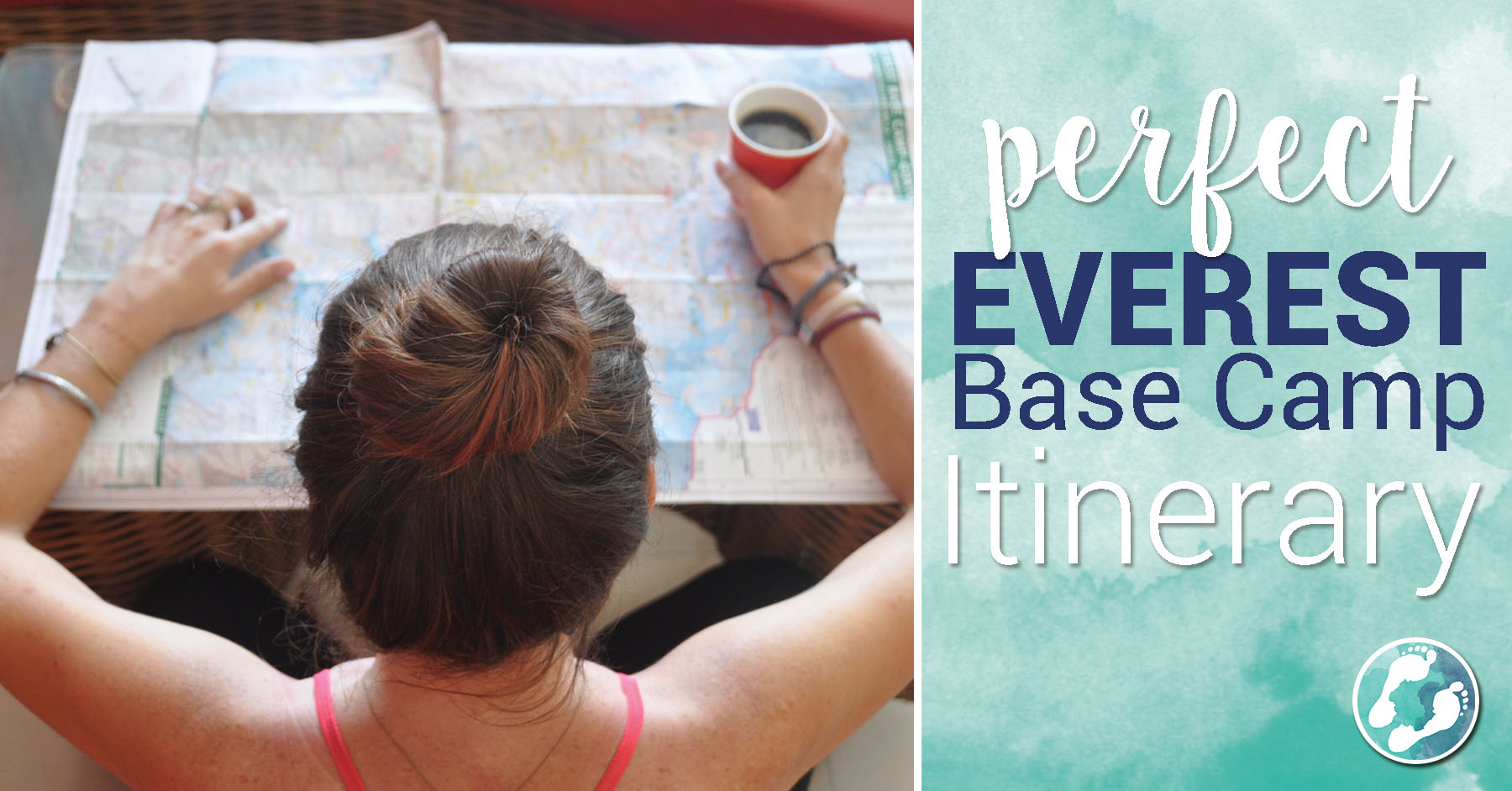
The Everest Base Camp trek can be dangerous, even fatal, if you don’t plan it out correctly. Before we laced up our hiking boots and began our hike to Everest Base Camp, we did some planning. A lot of planning.
We read blogs, compared itineraries, and looked at maps. We downloaded the Lonely Planet’s Trekking in the Nepal Himalaya travel guide and memorized their suggested route. We scoured TripAdvisor forums and read long-winded explanations of the best villages to stay in along the way. And after all that research, we narrowed our findings down to a route that was perfect for us.
This 16-day itinerary will bring you to Everest Base Camp, across the infamous Cho La Pass, and to the beautiful Gokyo Lakes. It has buffer days built in, so you have plenty of time to acclimatize.
This itinerary will give you an idea of what each day looks like, its difficulty level, and the name of the teahouse we stayed at (and if we’d recommend it).
We trekked at a slow to average pace (some may say a “turtle pace”), and we carried our own packs (without a porter). Take a look at our EBC packing list. To learn more about what life is like on the trail and how to do it yourself, check out our Ultimate Guide to Trekking Everest Base Camp.
Note: We did our trek from April 6th – 22nd, 2016.
Who is the Everest Base Camp Trek for?
We saw people of all ages and abilities making this trek. But be warned, it’s not easy. And even the fittest people can suffer from altitude sickness and fail to make it to base camp. We didn’t do much training for this trek at all, but we met several people who trained hard for an entire year before attempting EBC.
Can children trek to Everest Base Camp?
We wouldn’t recommend it. Come to think of it, the youngest person we encountered was maybe 16 years old, and that was a rarity. If you are planning on trekking in Nepal with kids, there are many other, less intense hikes that would be more suitable for young children.
EVERYTHING you need to plan your EBC trek!
There are a few trekking routes around Everest National Park (Sagarmatha National Park). We trekked the Everest Base Camp & Gokyo Lakes Itinerary shown below. Click the links to jump to that day on the trek.
Everest Base Camp & Gokyo Lakes Itinerary
*Note 1: If you are looking for the classic Everest Base Camp and back route, you would start heading back down from Day 10 from Kala Pattar – Pheriche – Namche Bazaar – Lukla.
*Note 2: Staying in Dugla on Day 7 is commonly skipped but we decided to stay here because we both got sick. Read more about what happened to us on Day 7.
If you have even more time, try looking into the Three Passes Trek. Check out the route in the Lonely Planet’s Trekking in the Nepal Himalaya travel guide.
Before starting your Self Guided Trek to Everest Base Camp
You’ll need to purchase travel insurance with high altitude coverage, which is not common on most policies. We saw far too many people get helicoptered off the trail because they got sick from the elevation. We purchased a policy from World Nomads, which high altitude coverage comes standard. We were at ease knowing that if anything happened, we were insured.
Day 1: Lukla to Monjo
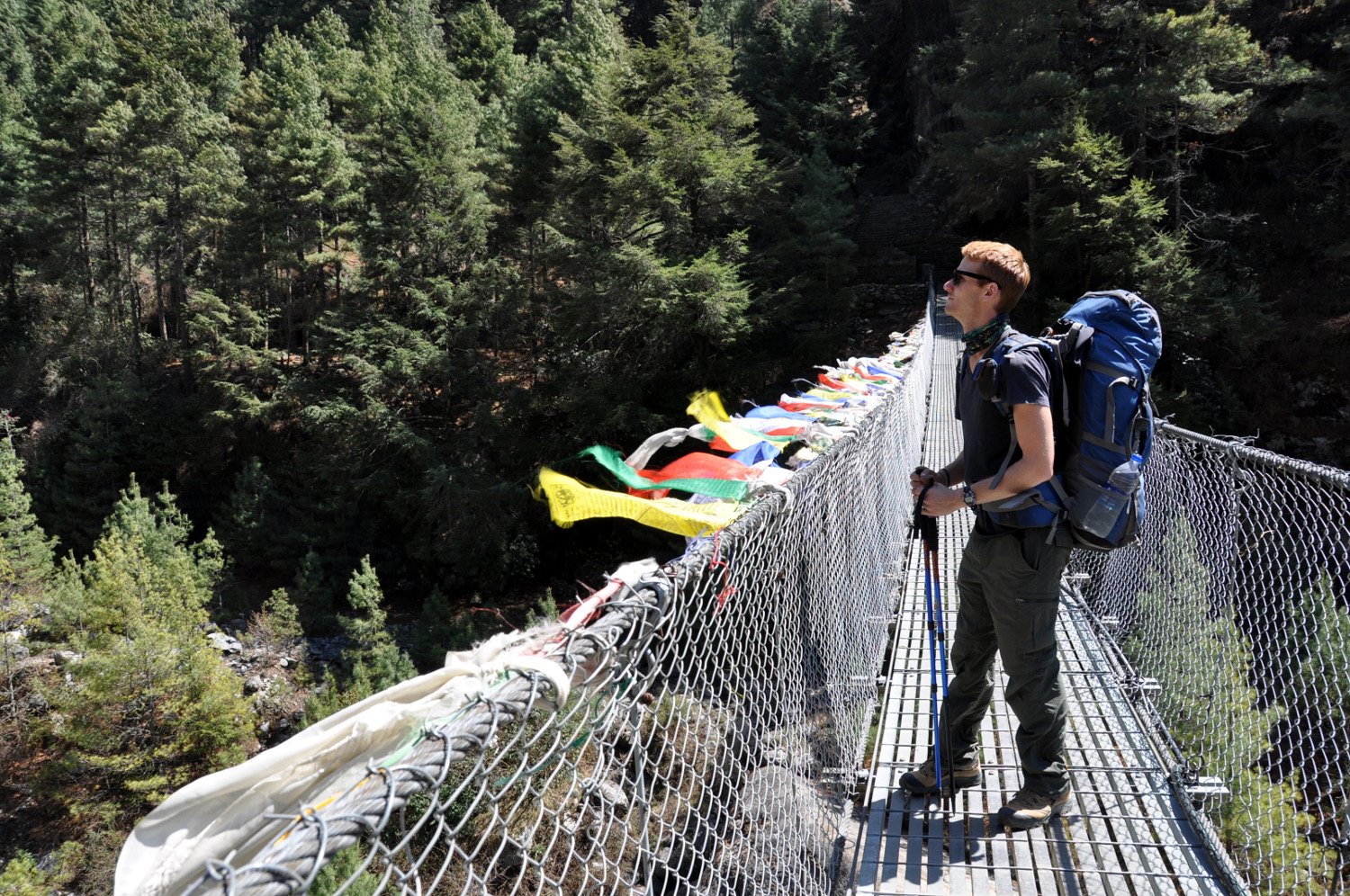
Total trekking time: 5 hours 15 minutes + Rest time: 45-minute lunch in Phakding
Description: Once your flight lands grab breakfast and coffee in Lukla (we ate at Everest Coffee Cafe), and then began hiking. Trek through beautiful scenery, crossed suspension bridges, passed by yaks, and smelled the cherry blossoms and rhododendrons.
Note: If you are flying to Lukla, it’s not uncommon for your flight to be delayed or even cancelled. Be prepared to get a later start than you were expecting.
Difficulty Level: 4 – Today was easy, with mild uphill and downhill portions.
Teahouse: Monjo Guesthouse
-
Cost: 200 rupees
-
Warm dining room, simple rooms, good views
-
Recommended: Yes
Tip: Many people spend their first night in Phakding, but we skipped it for a few reasons. First, Phakding is full of large lodges with big trekking groups, whereas Monjo is a bit smaller. Also, Monjo is at a higher altitude, which will help you acclimatize better and make your transition to Namche easier.
Lastly, the second day of the trek is long and tiring. By staying in Monjo the first night, you’ll get ahead of the crowds and cut significant time since you are closer to Namche. If you have time, we would recommend pressing on until Monjo for your first night.
Day 2: Monjo to Namche Bazaar
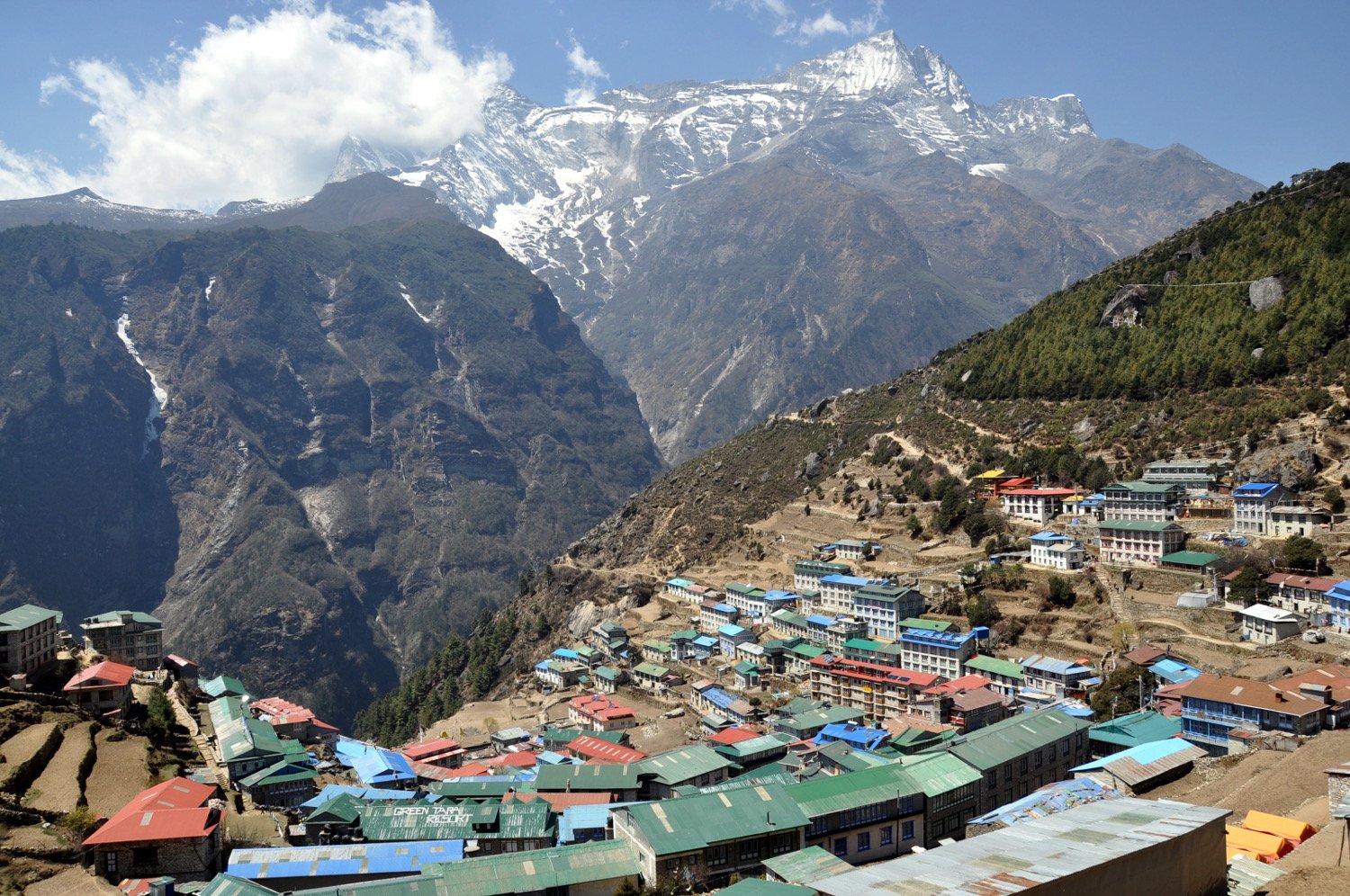
Total trekking time: 4 hours 30 minutes + Rest time: 30 minutes at the Namche check point
Description: Start the day crossing suspension bridges and easy walk, but after the last suspension bridge it is 2 hours or more of uphill hiking. 30 minutes before Namche there is a check point you must sign in at. Ours took 30 minutes because the power got shut off and had to reboot everything. Make sure to drink lots of water, at least 3 liters.
Difficulty Level: 7 – Easy first few hours, but the hill to Namche is a killer.
Teahouse: Khumbu Lodge
-
Cost: 300 rupees
-
Rooms have soft beds and good views (ask for a room facing the valley). It’s in a central location of Namche and has a big restaurant with tasty food.
-
This well-known lodge is popular with big expedition groups, and some famous climbers have stayed here throughout the years. The owner seemed to be well known in the climbing community. U.S. President Jimmy Carter and his wife stayed here as well in 1985.
-
Recommended: Yes
Tip: Try the fried potatoes with veggies and an egg. Good for breakfast or dinner!
Day 3: Namche Bazaar Acclimatization Day
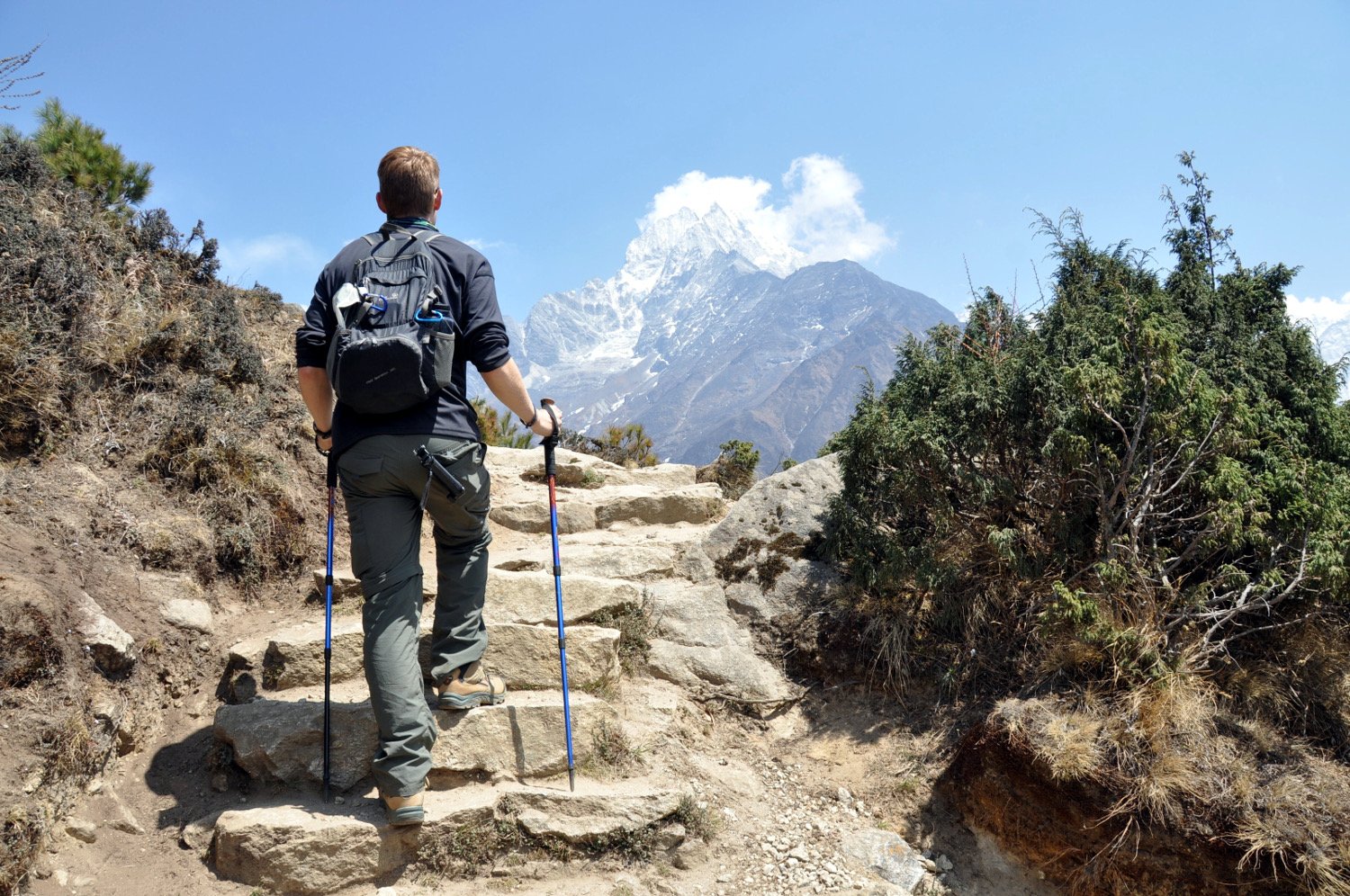
Total trekking time: Depends on day hike. 2 – 3 hours. We hiked to the Sherpa Museum for a view of Everest, about 1 – 1.5 hour round trip. Then we hiked up the hill over Namche to the Sherpa Village Lodge, about 1 – 1.5 round trip.
Difficulty Level: 4 – Pretty relaxed, easy slope to the Sherpa Museum. The hike up to the Sherpa Village Lodge was a steep climb but not too bad.
Teahouse: Khumbu Lodge (same as Day 2)
Tip: Next to Khumbu Lodge is Himalayan Java Café, which is a great spot to relax on your “rest day” after a morning hike. Make sure to get the walnut chocolate brownie, I dare you to try to only eat one!
Day 4: Namche Bazaar to Tengboche
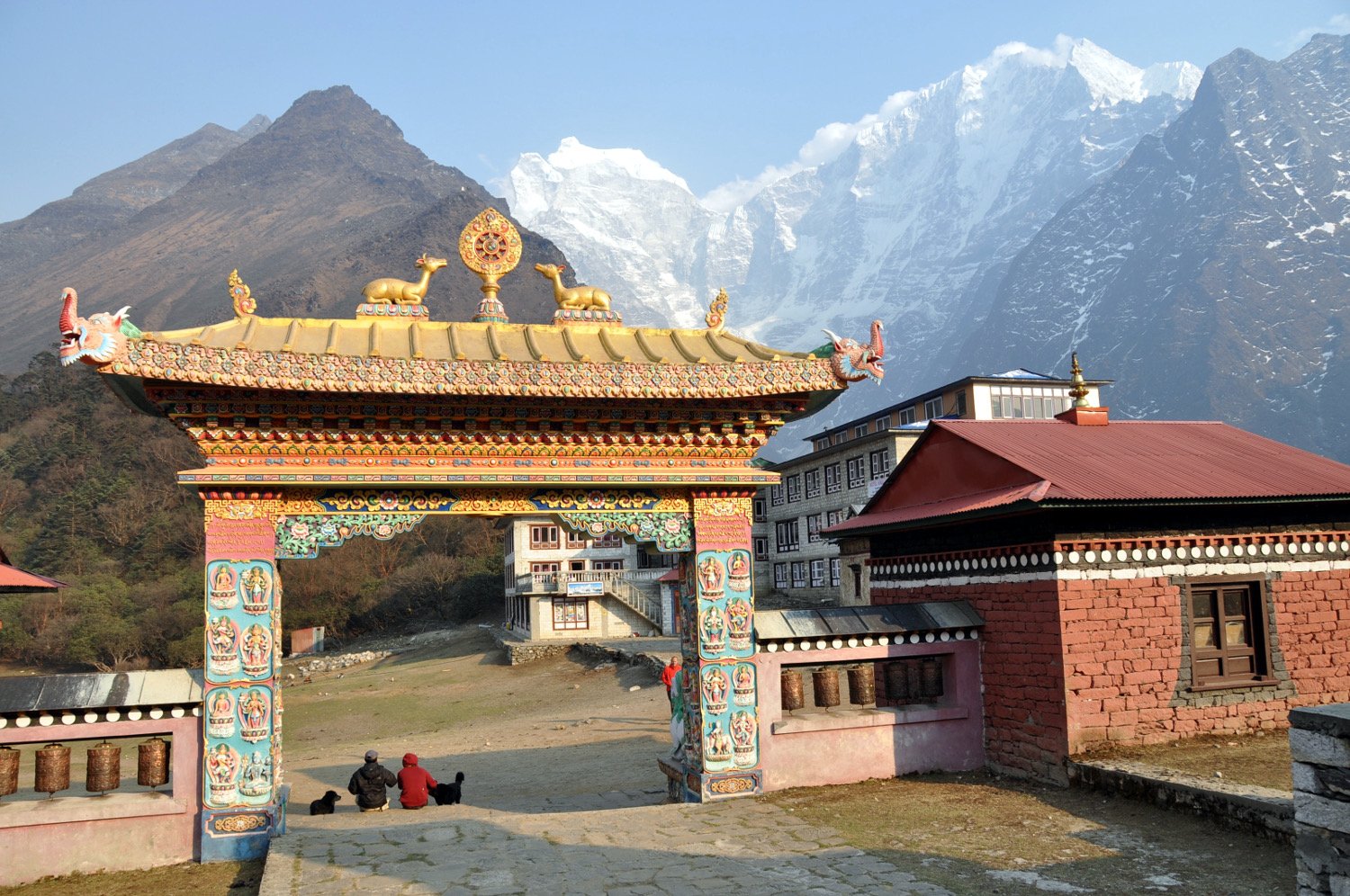
Total trekking time: 5 hours and 10 minutes + Rest time: 15-minute snack break in Khyangjuma and 45 lunch break in Phunke Tenga
Description: It’s a steep climb out of Namche and then a level walk for about 1 hour with views of Everest and surrounding mountains with river valley below. Then downhill for an hour before the 2 hours and 15 minutes zig-zag uphill through the pine forest before Tengboche.
Difficulty Level: 6.5 – Early easy walk on flat trail, but the down and then up were challenging.
Teahouse: Tengboche Guesthouse
-
Cost: 200 rupees
-
We had a small room and the bathroom cleanliness could be better, but the common area was warm and cozy.
-
Recommended: Yes
Tip: Once you’re settled in your room, visit the Tengboche Monastery. It’s the oldest in the region and had blessed Sir Edmund Hillary and Tenzing Norgay before their summit on Everest.
Day 5: Tengboche to Dingboche
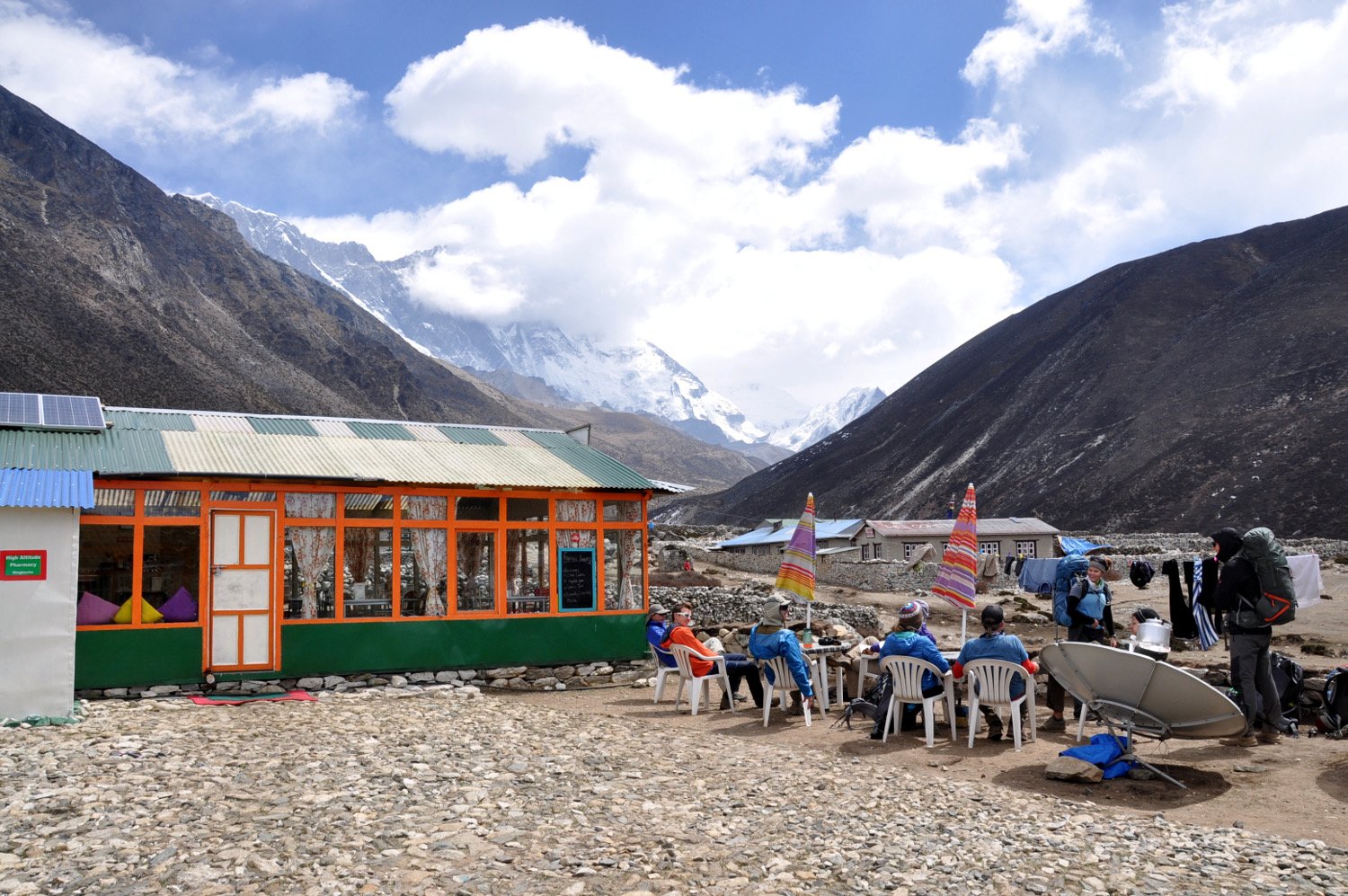
Total trekking time: 4 hours and 40 minutes + Rest time: 15-minute snack time
Description: After leaving Tengboche, there’s 30 minutes of downhill hiking within a woody forest. You’ll walk on a flat trail for what seem like hours, stepping over boulders along the way. Once you get above the tree line near Somane, the landscape make you feel like you stepped into the Lord of Rings film set.
Difficulty Level: 6 – Simple hike on a well walked trail, but by now the altitude can start to take an effect on your breathing.
Teahouse: Snow Leopard Lodge
-
Cost: 100 rupees
-
The rooms are simple and quite large. The common room is comfy with a great restaurant. The best part the attached bakery where you can order a strong coffee, cheesecake and apple pie!
-
There’s also a small pharmacy where it’s your last chance to stock up on medications or cough drops before heading to higher altitudes.
-
Recommended: Yes, highly recommended!
Tip: There is no cell service in Dingboche and the WiFi options are terrible. Just enjoy being off the grid for a few days and eat some cheesecake.
Tip: Many people spend their night and the next day resting in Pheriche, however we found more benefits to staying in Dingboche. It’s at a higher altitude so your body can adjust better. This could allow you to travel to Lobuche on Day 7 if you would like (we didn’t because we wanted to take it slower due to us getting a little sick). Dingboche also has the amazing bakery that we could spend days relaxing and eating.
Day 6: Dingboche Acclimatization Day
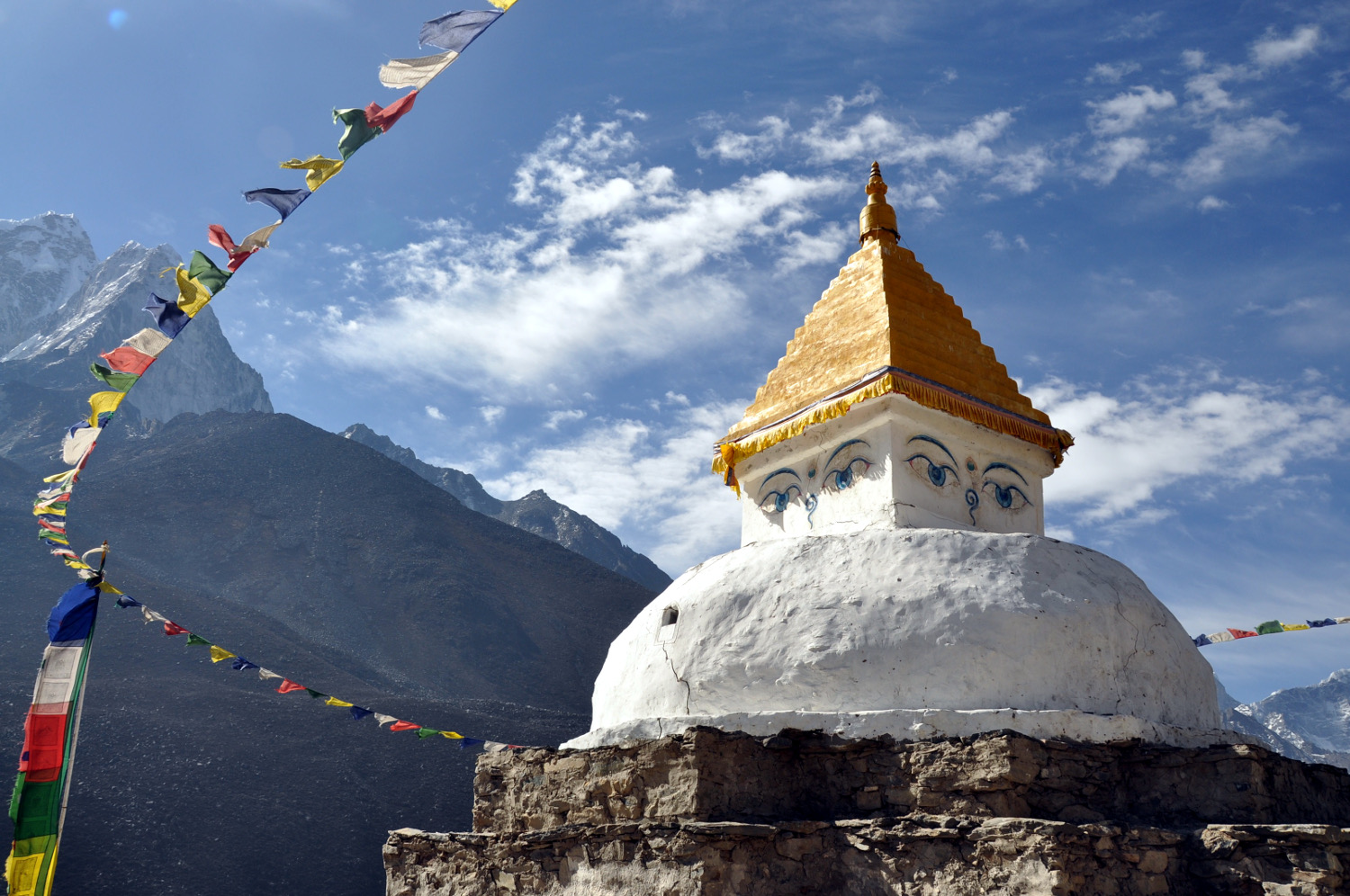
Total trekking time: 2-4 hours depending on day hike
Description: We were not feeling great with a tooth infection and a bad cold so we only hiked an hour up the hill overlooking Dingboche. There are some sweet views of Ama Dablam and other Himalayan giants with prayer flags at the viewpoint. If you wish, you can climb another hour or so to the top of the hill for even better views, but bring a wind breaker jacket.
Tip: Spend the rest of your acclimation day in the Snow Leopard Bakery. Order the cheese cake or the apple pie, you won’t be disappointed.
Difficulty Level: 6 – You get to hike without your packs, but the altitude really starts to hit you as you climb up the hill.
Teahouse: Moonlight Lodge
-
Cost: 100 rupees
-
The family running the lodge is extremely kind and welcomes you into their cozy family circle around the central stove. However, the rooms were pretty small and cold and the food was nothing special.
-
Recommended: Yes, only if the Snow Leopard Lodge is full
EBC Video Diaries
Watch Part 1 of our video diary from Day 1 through 6 of our trek. This will show you what life is like on the trail, plus we included some funny scenes for your entertainment.
Day 7: Dingboche to Dugla
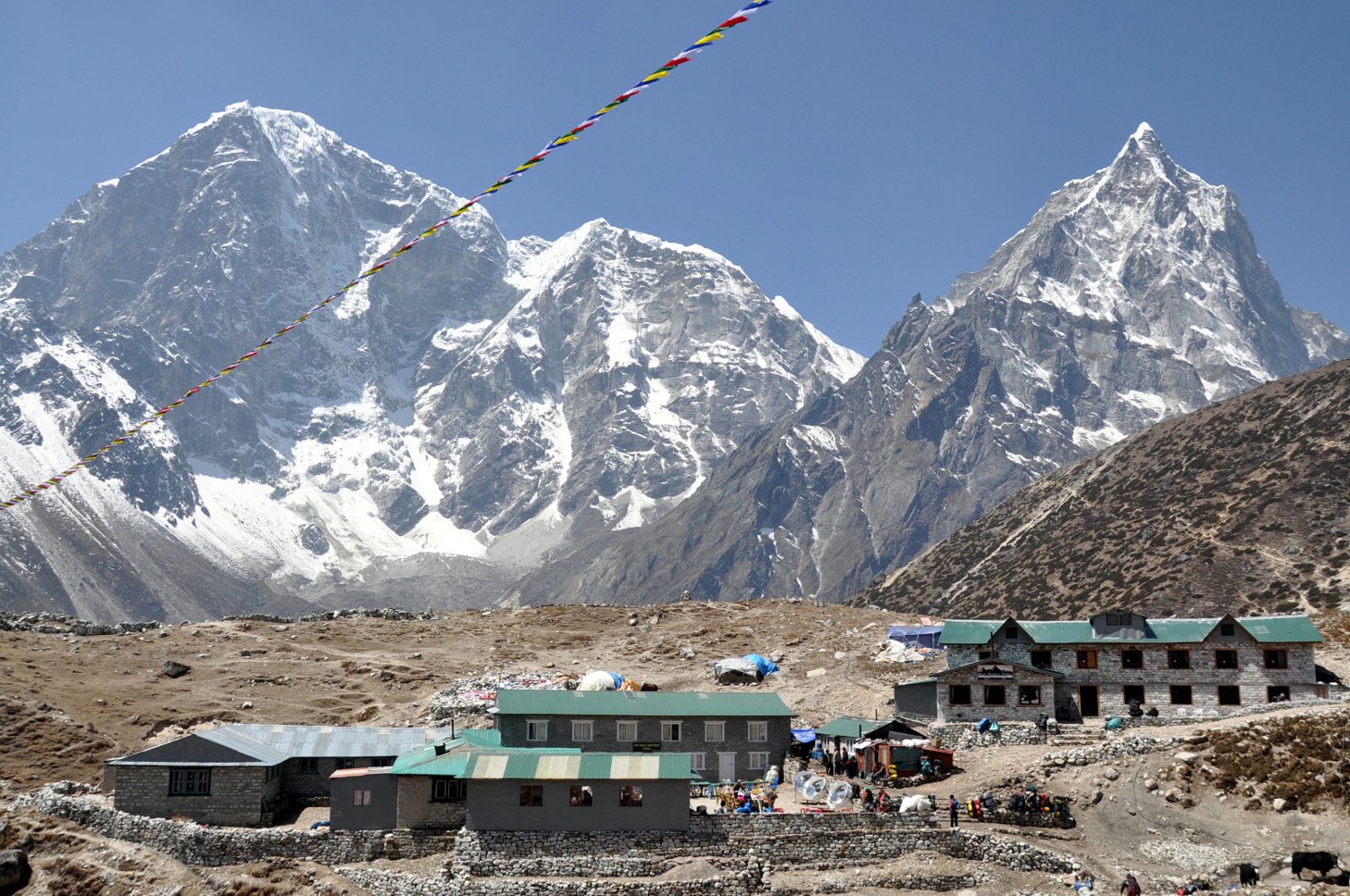
Total trekking time: 2 hours and 15 minutes
Description: It’s an easy gradual slope that leads into Dugla. There are epic views throughout the entire hike to the south. Take the rest of the day to rest and recover, there is not much to do in Dugla.
Note: Most trekkers continue on to Lobuche on this day. However, Katie had a bad cold and Ben had a tooth infection, so we both needed an easy day with lots of rest (and medication). This shows the importance of going at your own pace and not pushing your limits. After one night in Dugla, we felt much better and continued on our regular route.
Difficulty Level: 5.5 – One of the easiest and shortest days on the trail.
Teahouse: Yak Lodge
-
Cost: 100 rupees
-
The rooms were simple and the food was mediocre with prices starting to increase. It was enough to fill your tummy, but not that tasty.
-
Recommended: Yes, if you stay in Dugla there are only two choices, and this is the cheaper option.
Day 8: Dugla to Lobuche
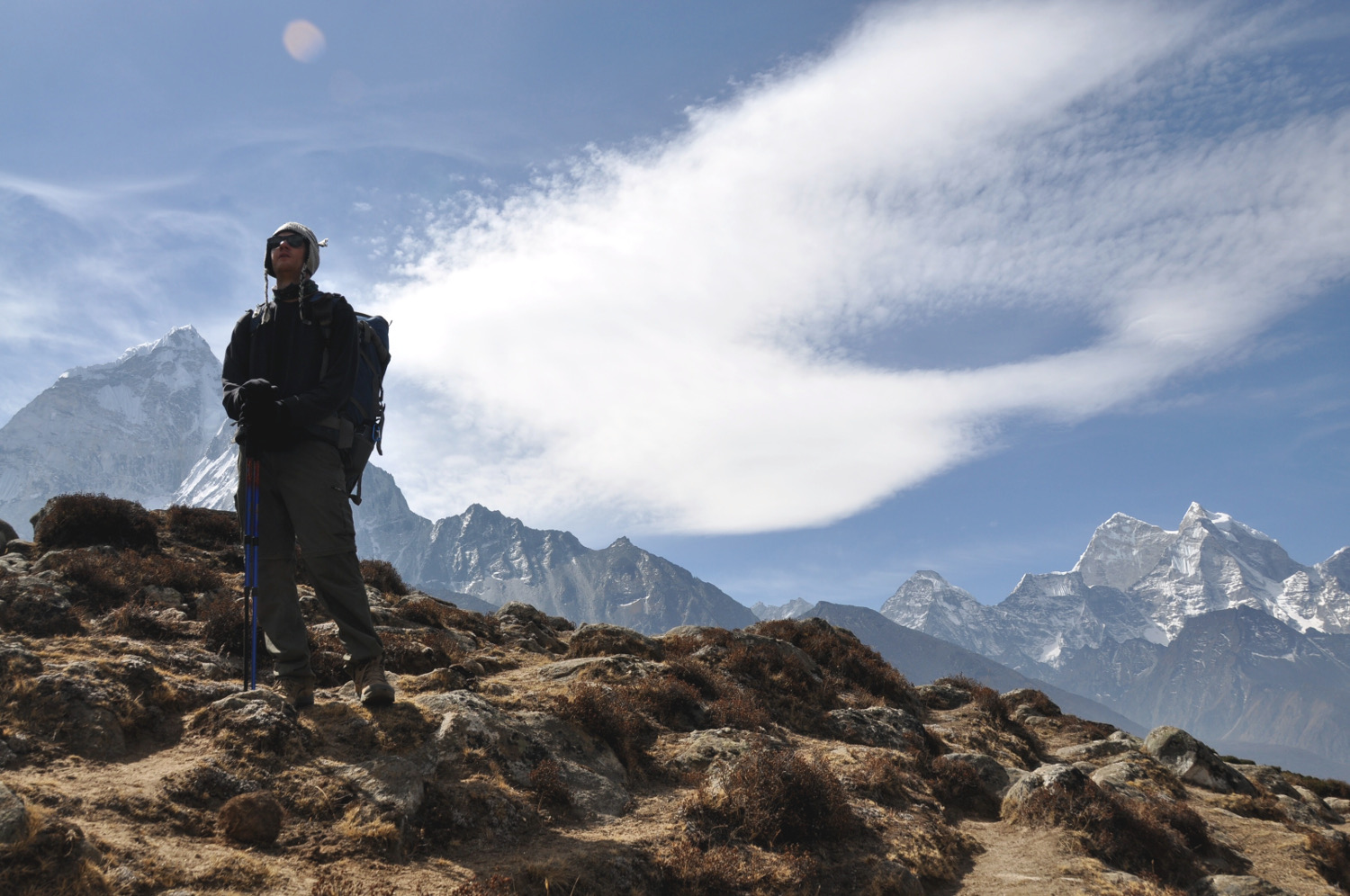
Total trekking time: 2 hours and 30 minutes
Description: Leaving Dugla, the extremely difficult uphill climb takes about 1 hour. Once you’re at the top breathing is difficult, but luckily it’s pretty flat the rest of the day trekking over rocks and boulders.
At the top of the hill, there are numerous memorials for climbers who’ve lost their lives climbing Everest, including one for Scott Fisher who perished in the 1996 disaster.
Hiking 30 minutes past the top of the hill, you can see the trail to the west that leads to Dzongla. Keep that in mind for Day 11 when you’ll be heading down that way.
Difficulty Level: 8 – Hardest day so far. The uphill climb in the morning is a bitch and you’ll be so happy once you’re at the top.
Teahouse: Mother Earth Lodge
-
Cost: 200-500 rupees
-
The rooms were a decent size, but not very cozy. There are different prices depending on which room you choose, but from what we saw there is no difference in the rooms (the only difference was that the more expensive rooms has trash bins, ours did not).
-
Recommended: No, go stay at Oxygen Altitude instead (We stayed there on Day 10 and liked it a lot more).
Day 9: Lobuche to Gorak Shep to Everest Base Camp!
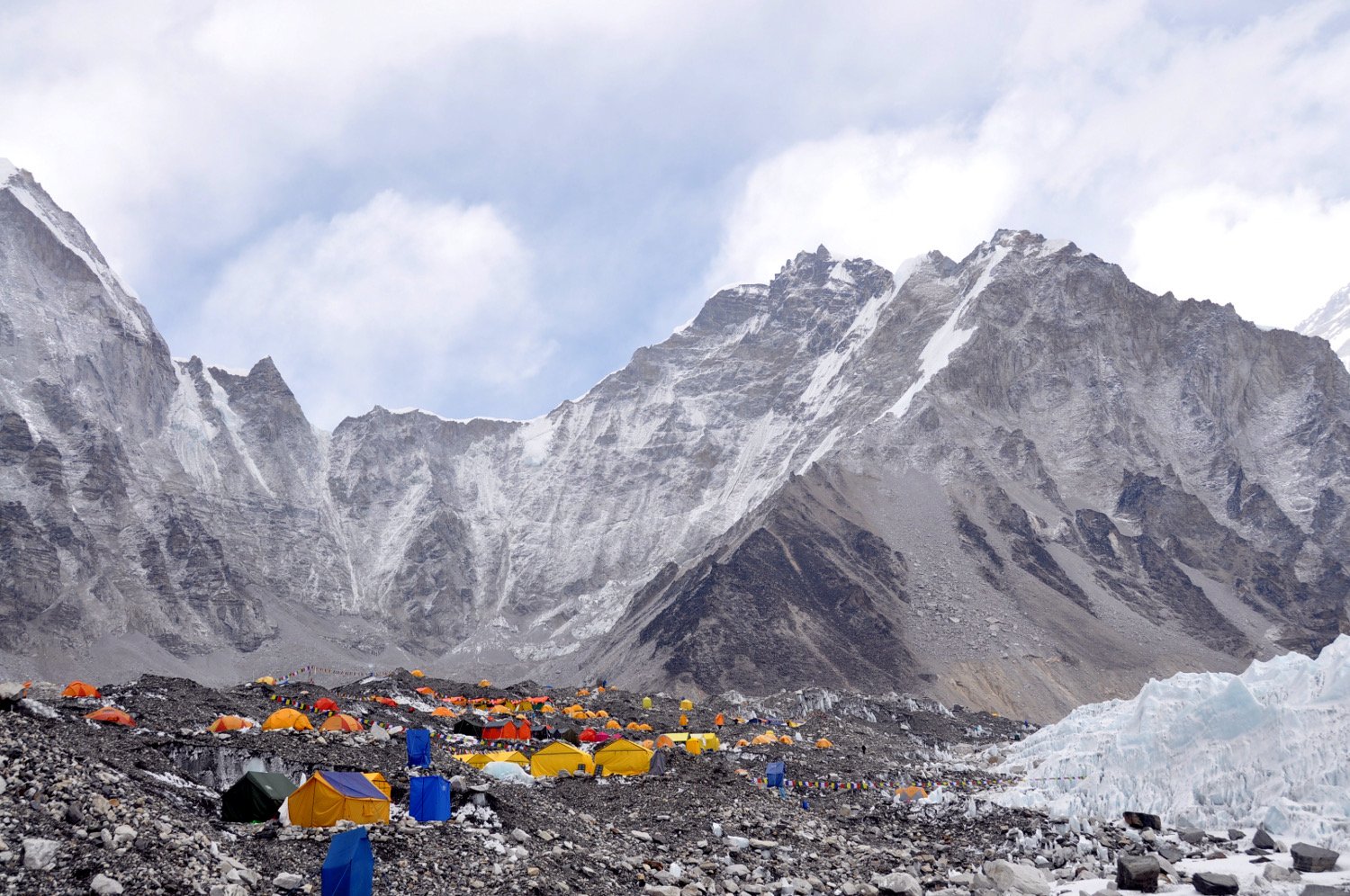
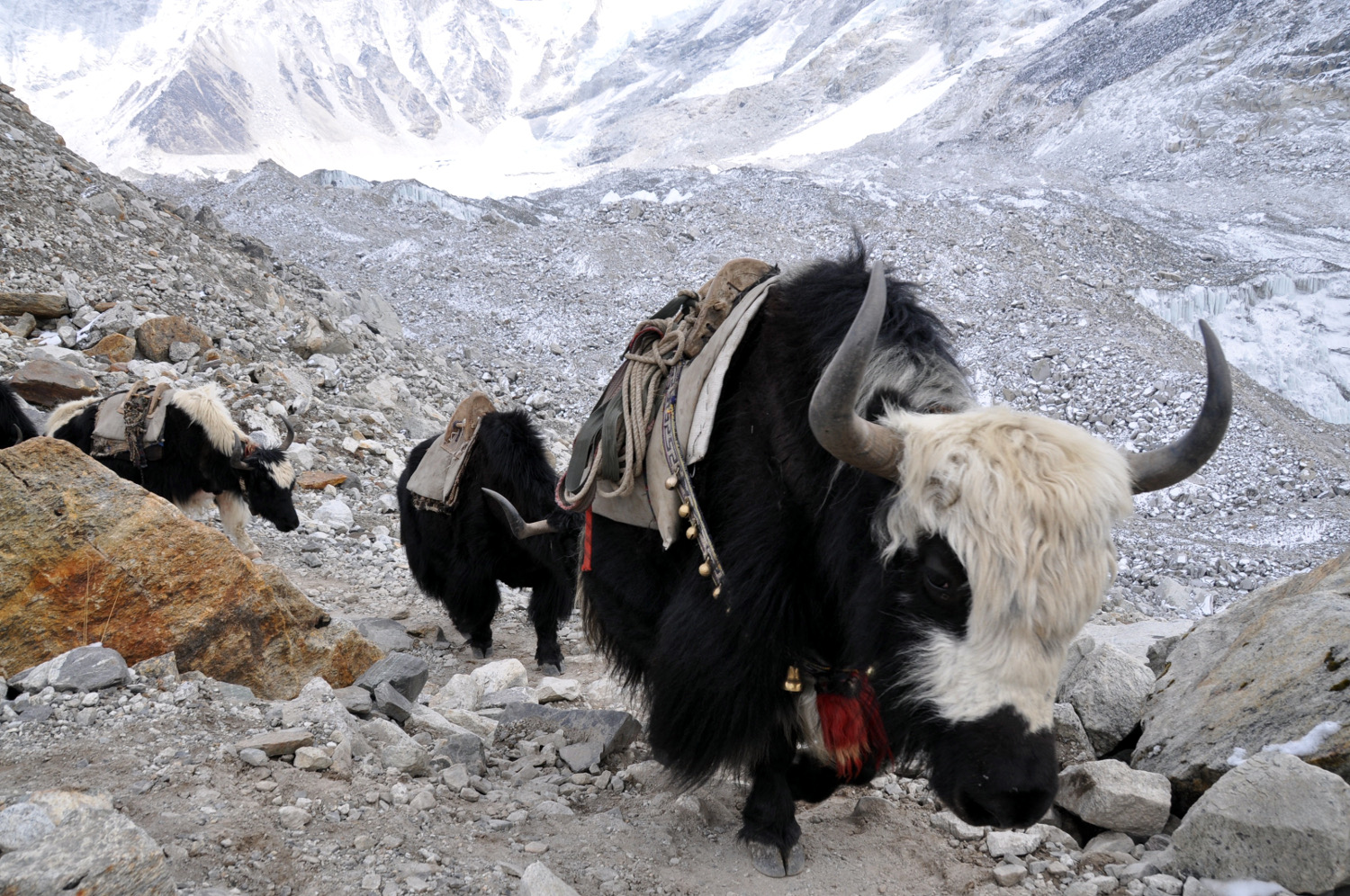

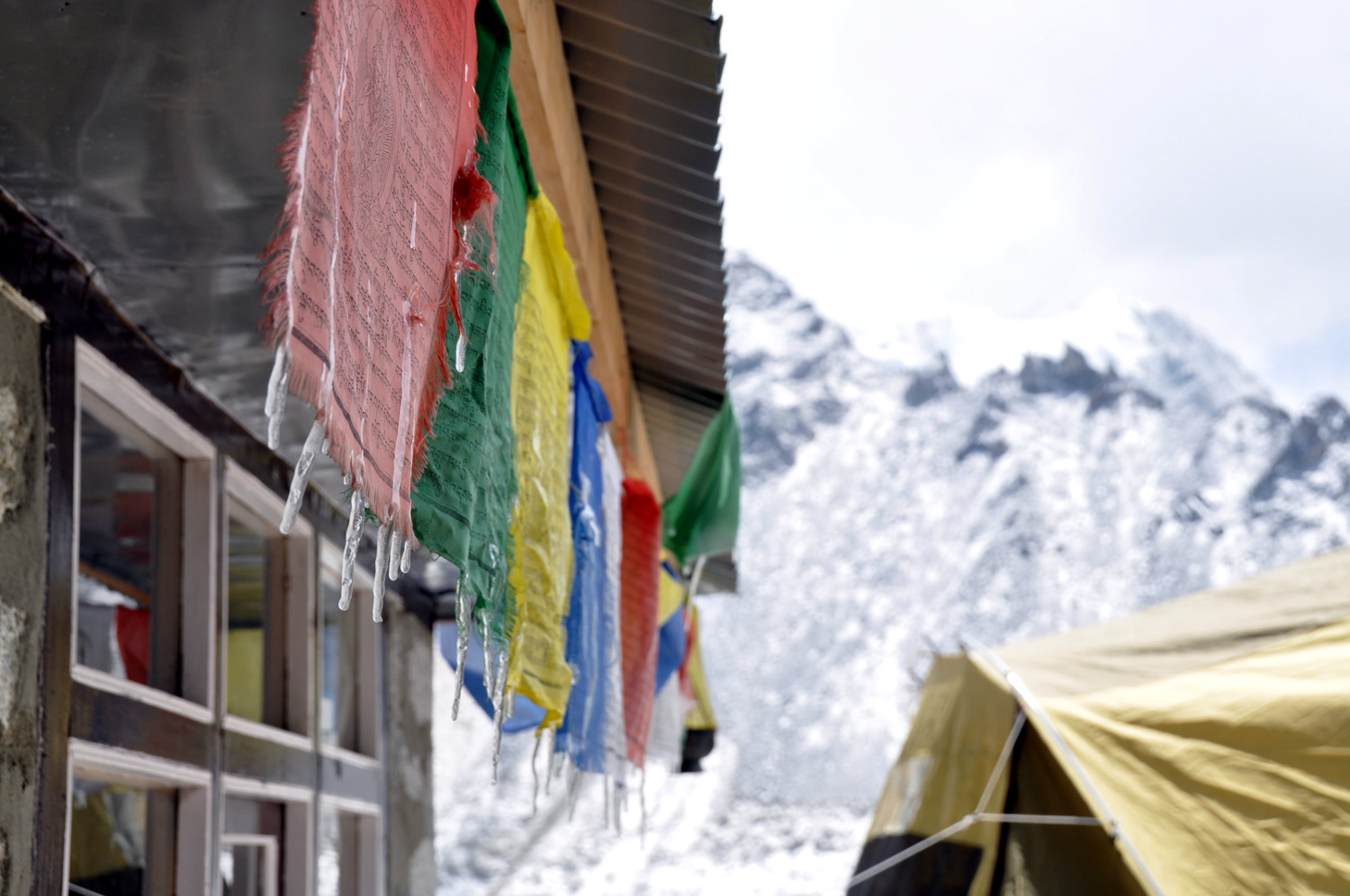



Total trekking time: 6 hours and 25 minutes + Rest time: 1 hour lunch and 1 hour at Base Camp
Description: From Lobuche it’s an easy stroll for about 1 hour and then it gets pretty steep. Climbing over boulders and crossing glacial streams would be fun it wasn’t for the whole struggling to breathe thing.
Once at Gorak Shep, grab a quick lunch, because it’s only another hour and a half to EBC. You’ll be happy to drop off your big pack, which now feel three times as heavy, for the last hike to Base Camp.
The trail from GS is full of short ups and downs over loose rocks, but there are a few flat parts. You’ll know when you’re at EBC because there will be a few people gathered around the famous rock and flag pile. Time to celebrate! You made it to Everest Base Camp!!
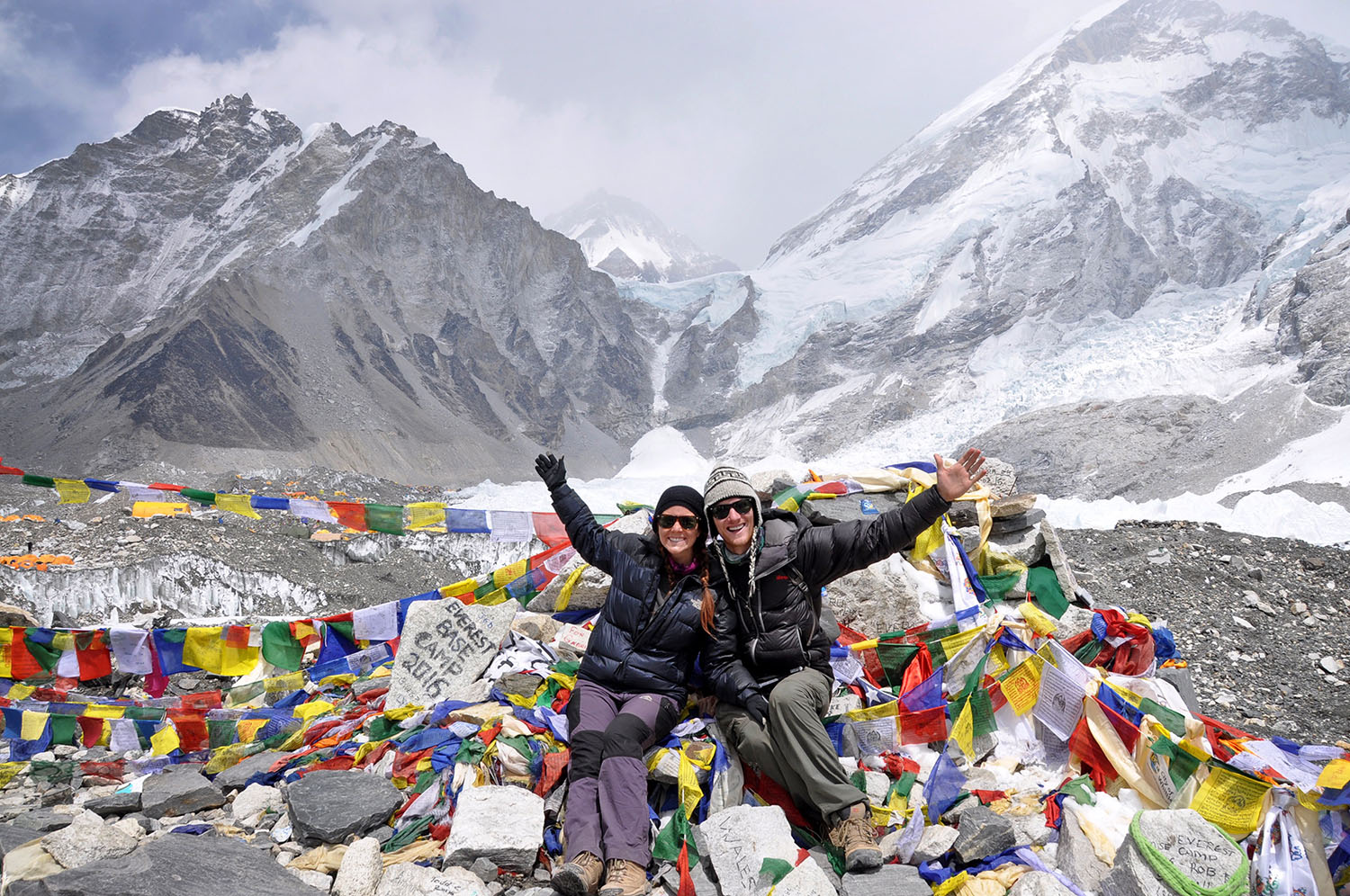

Tip: Don’t forget to pack extra batteries because it would be the worst if your camera died for this once in a life time moment. It’s also nice to have a celebratory Snickers bar to have once you reach the top!
Difficulty Level: 8 from Lobuche to Gorak Shep, and 7 from Gorak Shep to EBC – We were surprised on how (relatively) easy the hike is from Gorak Shep to Base Camp. It’s probably because we didn’t have packs on, which was really nice.
Teahouse: Buddha Lodge
-
Cost: 200 rupees
-
The guide book says “cozy” but I say cramped and busy. There’s hardly any place to sit during meals because the tour groups have reserved tables. Room is simple and cold, but what do you expect at 5180 meters?
-
Recommended: Yes, but don’t really expect much.
Tip: The potato veg with cheese is pretty good, but maybe the altitude was messing with my taste buds too.
Tip: Many people don’t sleep well at Gorak Shep because of the altitude. To counter that, we both drank about a half liter of electrolyte water before bed and again once we woke up. Surprisingly, we slept like babies up there, expect for the mandatory midnight bathroom run thanks to Diamox side effects.
Day 10: Gorak Shep to Kala Pattar to Lobuche
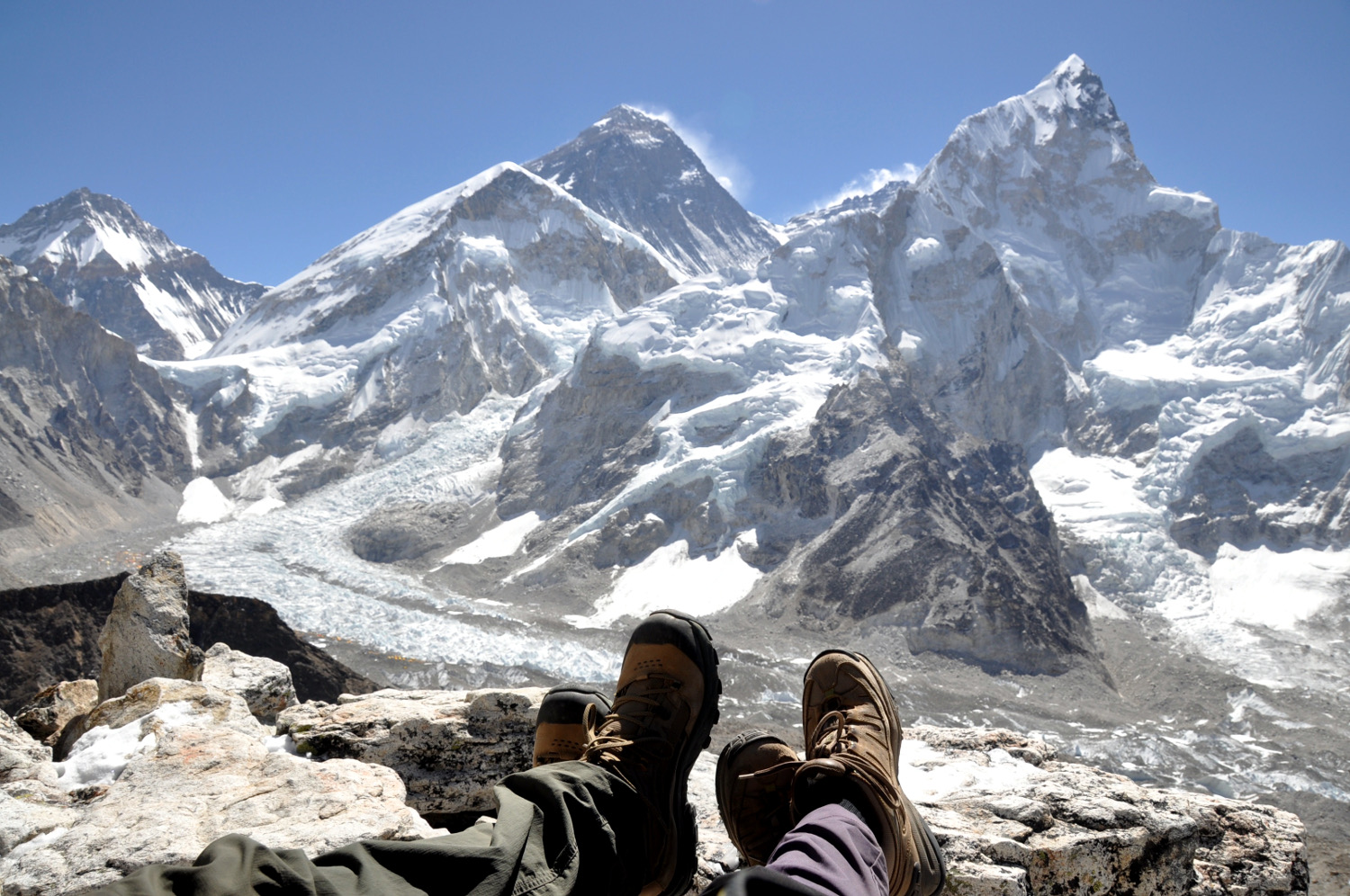

Total trekking time: 5 hours and 45 minutes + Rest time: 30 minutes at the top of Kala Pattar and 1 hour for lunch in Gorak Shep
Description: Don’t have too high of expectations for Kala Pattar, it’s honestly just a massive rock pile. But the views from the top are incredible!
Make sure you have a decent breakfast before you start otherwise you risk being a baby like Ben was because he was low on sugar.
At the top, you will have 360 degree views of Himalayan giants like Khumbutse, Changtse, Lhotse, Nuptse and of course Everest, which looks like a black diamond peering over the shoulder of the other mountains.
Once you have taken it all in at the top, head down and grab your pack and start heading back to Lobuche. You’ll feel like you could run a marathon as you come down from the mountain, it’s a pretty cool feeling. The hike from Gorak Shep to Lobuche is about the same difficulty as coming up the day before.
Tip: Bring other candy bar to celebrate at the top, or if you are Ben, you eat it 20 minutes in because he was low on blood sugar and could barely walk.
Tip: If for some reason you cannot make it to the top of Kala Pattar, like if you’re not feeling well or running short on time, it is totally okay. Honestly, the views are about the same at the one hour mark up the hill as the 3 hour mark at the top. The only difference is some mountains appear more visable and the glacial lakes show up below.
Difficulty Level: 10 – Kala Pattar is one of those hills that just seem to get higher and higher the further you climb. At that altitude, you need to take your time. It seriously took us 3 hours to reach the top of KP and only 40 minutes to get down.
Teahouse: Oxygen Altitude
-
Cost: 300 rupees
-
This place has really done a good job on making you feel at home. The rooms are huge and the beds are really comfy. The veg momos, veg curry and veg pasta are all good (and us fattys ordered them all in one meal)
-
Recommended: Yes, it’s the best accommodation in Lobuche.
EBC Video Diaries
Watch Part 2 of our video diary from Day 7 through 10 of our trek. It shows you what Everest Base Camp is really like and the incredible views from Kala Pattar.
Day 11: Lobuche to Dzongla
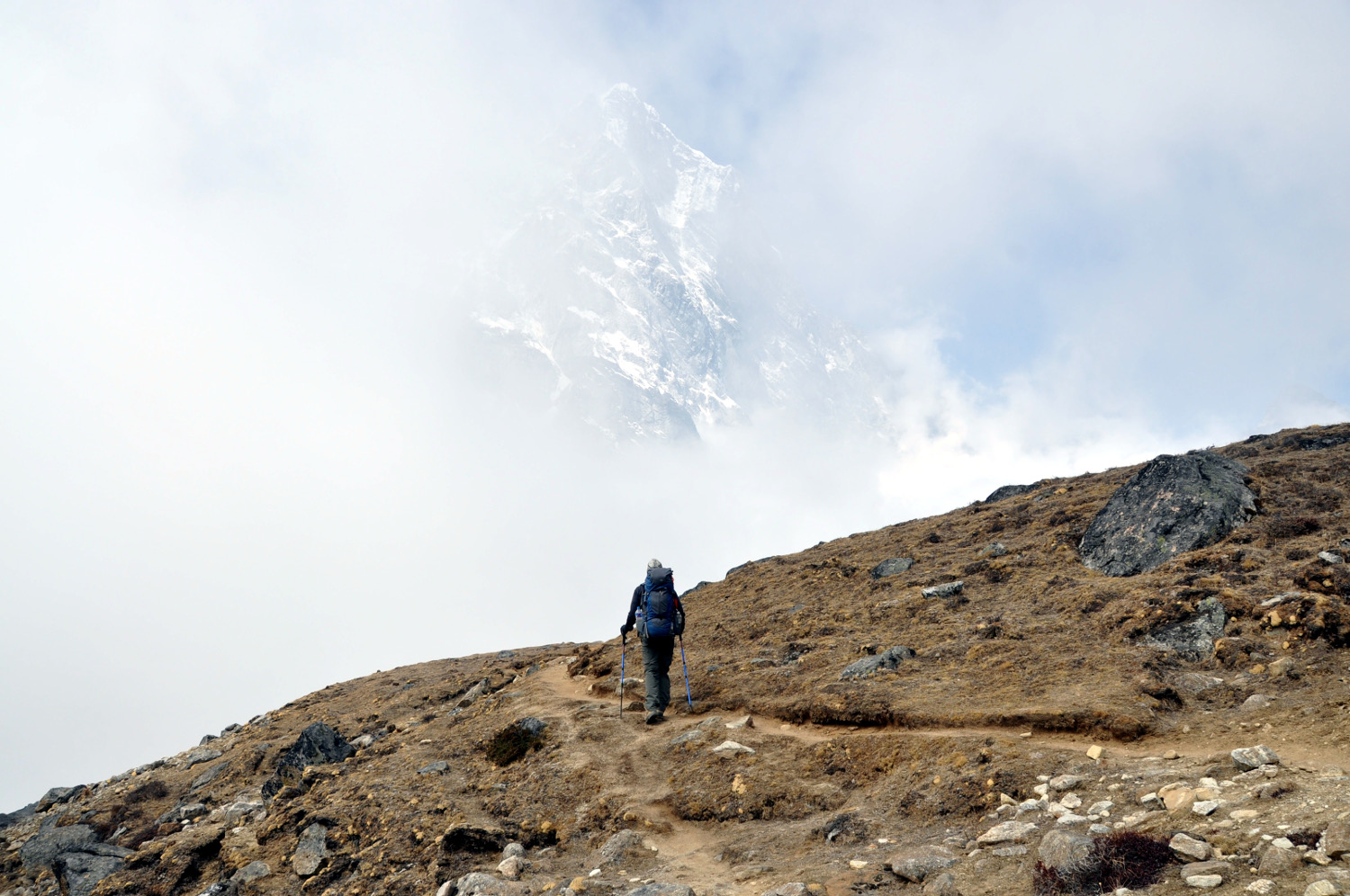

Total trekking time: 3 hours
Description: Heading south from Lobuche you will come to a fork after about 25 minutes. Instead of veering left on the same trail you came up on from Dugla, take the path to the right and stroll along the side of the mountain with great views of Cholatse to the south and Ama Dablam to the east.
Tip: As you make your turn to the west,take the path that leads down into the valley and not up the hill. Follow the river upstream and you’ll be fine. We got a little lost and had to scale down a couple hundred meters to find the correct path.
Tip: Make sure to leave early in the morning because around 11 a.m. thick clouds are commonly roll in the valley and it’s difficult to see the route.
Difficulty Level: 6.5 – Pretty flat trail that gradually slopes downward and then a small uphill right before Dzongla.
Teahouse: Mountain View Lodge
-
Cost: 200 rupees
-
Simple lodge with basic rooms, but has really good food.
-
Recommended: Yes
Tip: Tell the hotel owner the night before your breakfast and take-away lunch order for the next day because you’ll be leaving really early.
Day 12: Dzongla over Cho La Pass to Gokyo
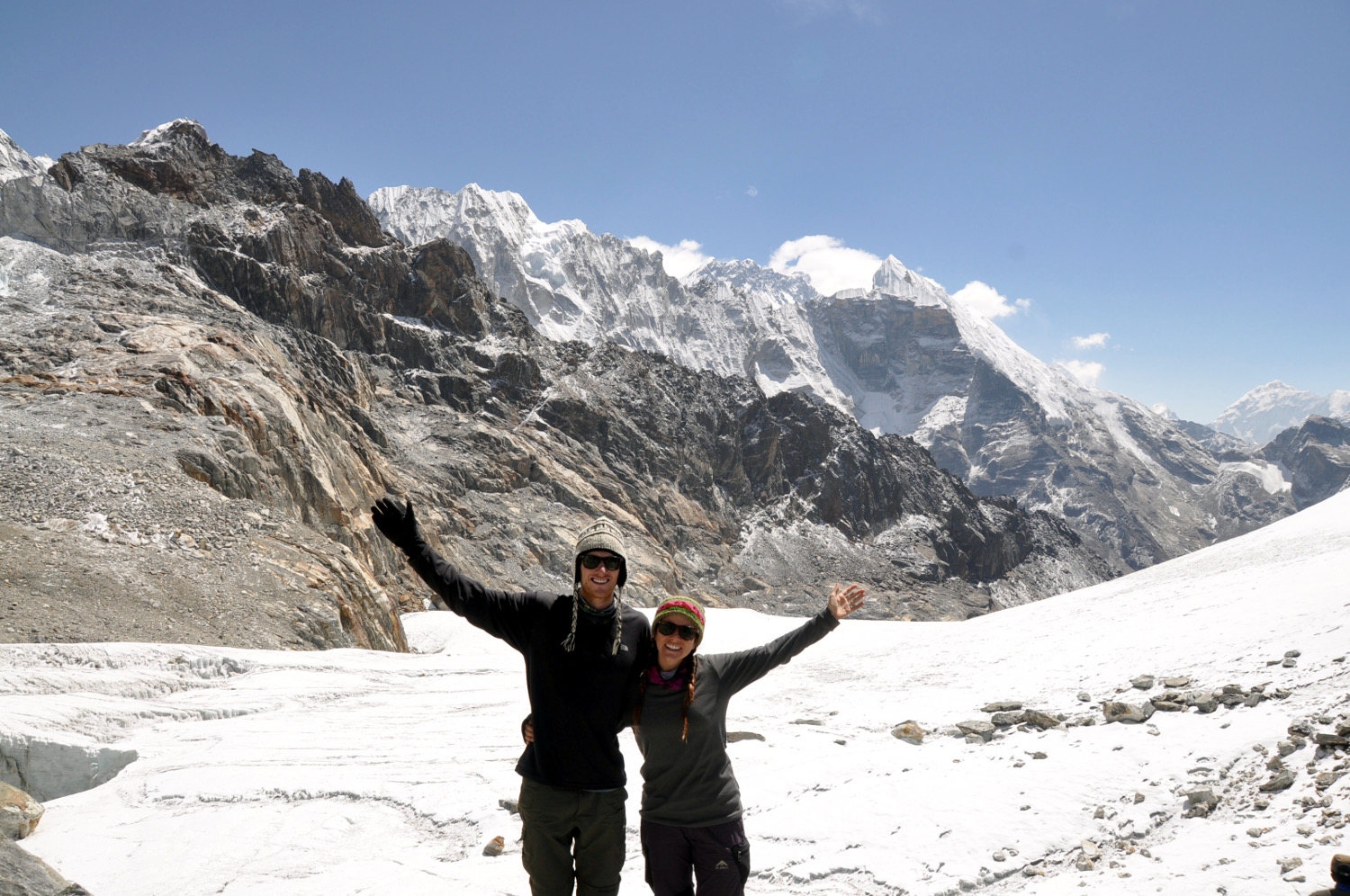

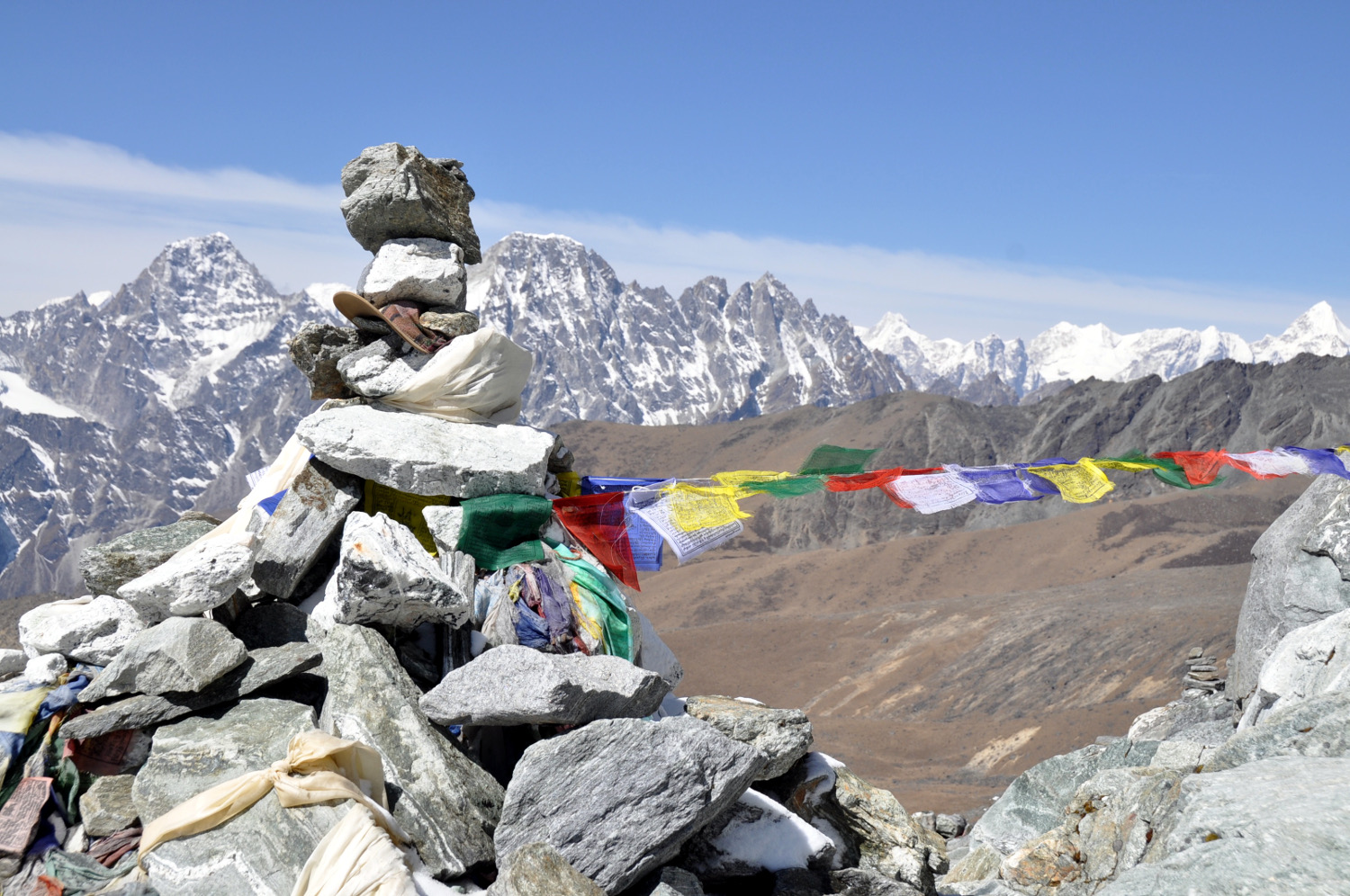



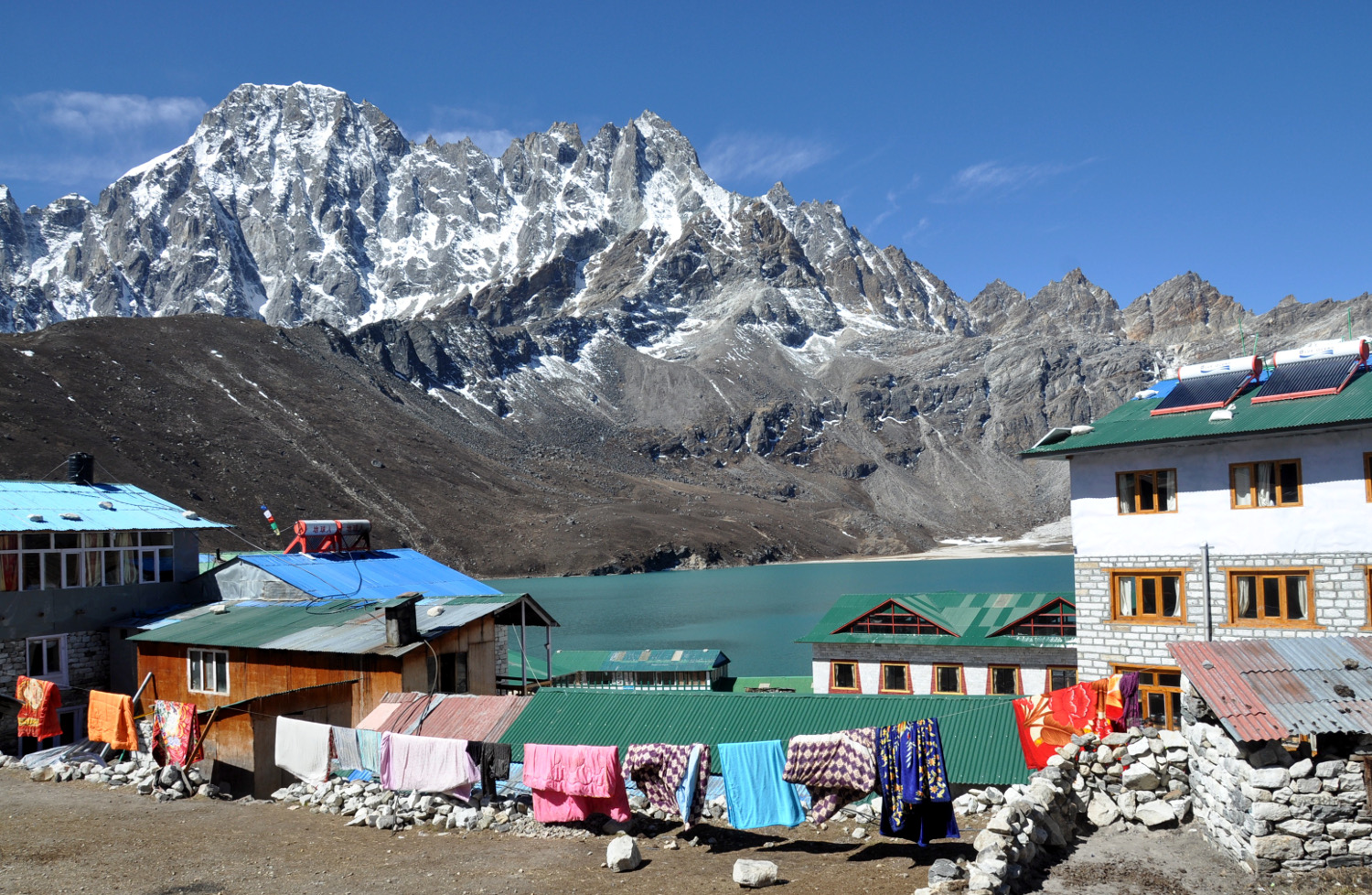



Total trekking time: 8 hours + Rest time: 1 hour at the top of Cho La Pass and 1 hour in Thangnak for lunch
Description: It’s recommended to reach the top of Cho La pass before 9 a.m. because the glacier ice at the top can start melting later in the day, making it dangerous to cross.
So an early start around 5:30 a.m. is required to make it in time. It’s an easy stroll leaving from Dzongla and then there’s a steep climb up a rock hill.
As you approach the rock face, turn right, and go up at a 45 degree angle climbing over boulders. You’ll be rewarded with an excellent view behind you once you make it up the top. Continue hiking and stay to the left, traversing boulders as you can see the tongue of the glacier to your right.
Once the boulders end, cross the glacier with a wide angle, not going uphill too much. You don’t want fall in the glacier pool right before the pass. When you reach the top of the pass, celebrate and rest for a bit, you deserve it.
Once you had your fill of the view at the top, hike down the slippery rocks, loose gravel and traverse massive boulders. Next, trek uphill over a short mound and then back down again a narrow valley that leads to Thangnak.
After lunch in Thangnak, hike north, parallel with the glacier on the east side of the moraine wall, until you see a white flag signaling you to climb into the glacier field. Try your best to follow the maze of stone cairns while admiring the turquoise pools until you reach the west wall of the glacier moraine. Hike over the wall and down into your final destination of Gokyo. Wow! What a day!
Difficulty Level: 9.5 – It’s a difficult climb up to the pass, but your body should be acclimatized after coming from Everest, so it’s not too bad. Trekking from the other direction would be a much more challenging task. Also, take your time hiking down the steep rocks leading down from the pass. We slipped a few times and it could create a “rocky” situation for anyone below you.
Teahouse: Gokyo Resort
-
Cost: 200 rupees
-
Try to snag a room on the second floor with nice views of the lake. The restaurant has good food and the staff is extremely friendly.
-
Recommended: Yes
Tip: Try to restrain yourself from buying every pastry item from the attached bakery because you’ll run the risk of spending your last rupees. But you do have to try the apple pie and brownies, you might never leave Gokyo.
Day 13: Gokyo Sacred Lakes and Rest Day
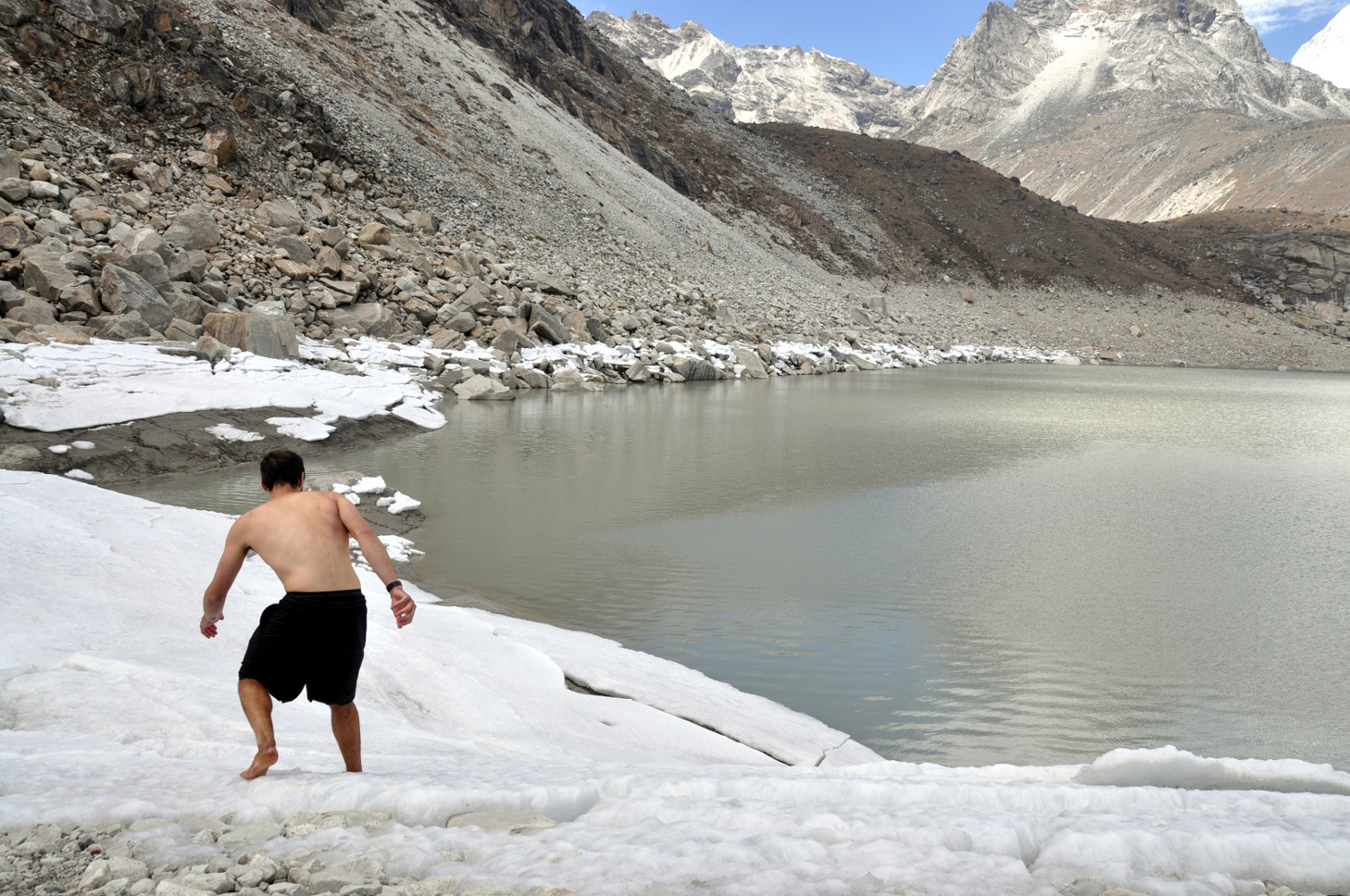



Total trekking time: 3 hours and 50 minutes + Rest Time: 40-minute stop at the 4th lake and 45 minutes at the 5th lake
Description: Relatively easy gradual slope heading north with some ups and downs. The route can be a little tricky, but just stick to the lakes and hills and away from the glacier, because we came across a trail that fell into the glacier.
Make sure to climb up to the glacier moraine just east of the fifth lake for a great view of Everest and surrounding mountains.
Tip: If you are really crazy, bring a towel and a change of warm clothes after taking a freezing dip into one of the lakes. If you want to play it safe, try dunk yourself in the 3rd lake that is right next to Gokyo so you can thaw out next to a stove.
Difficulty Level: 6.5 – Pretty easy with a few ups and downs, but there are many trails crisscrossing so stick to the hills.
Teahouse: Gokyo Resort (Same at Day 12)
Tip: After your day hike, spend the rest of the day in the bakery with coffee and yummy baked goods, you won’t regret it.
Day 14: Climb Gokyo Ri then Gokyo to Dole
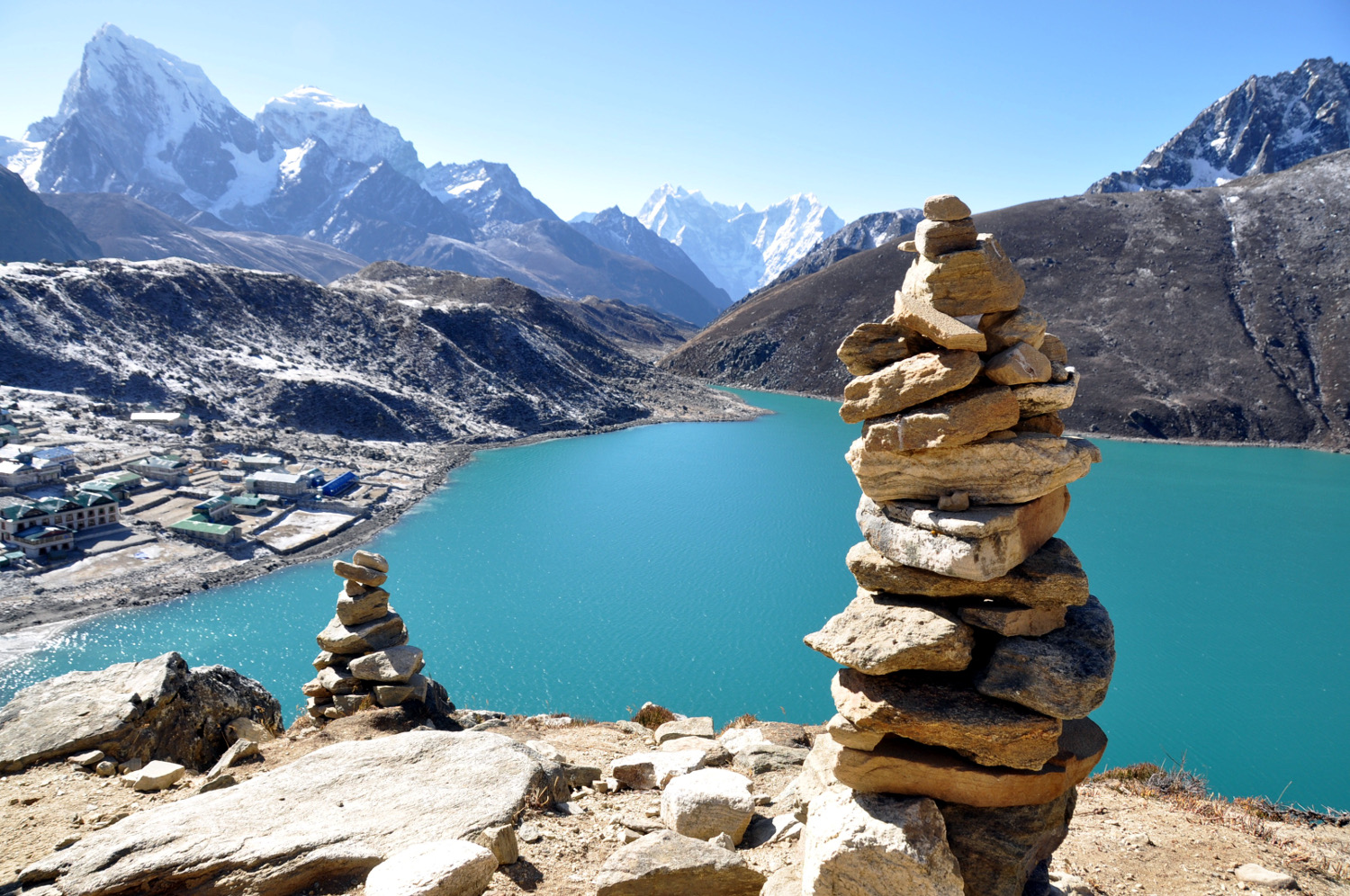



Total trekking time: 8 hours and 15 minutes (3 hours return up Gokyo Ri) + Rest time: 1 hour lunch break
Description: Gokyo Ri is challenging straight uphill hike, but you’ll be impressed with the views from the top. After climbing back down you’ll finally start heading downhill. Whao-hoo!!
You’ll get to see the remaining Sacred Lakes (which the 1st lake is more like a puddle) as you walk down into the valley. Passing through many small villages, take a lunch break at any one of them. Continue until you reach Dole.
Difficulty Level: 5.5 – Gokyo Ri is like Kala Pattar, but since your body is more use to the altitude you should be fine hiking it. Don’t get me wrong, it sucks, but you’ll be rewarded once you reach the top.
Beside the Ri, the rest of your day is easy. You’ll enjoy getting more oxygen back into your lungs and body as you go lower and lower.
Teahouse: Yeti Lodge
-
Cost: Free, but had to eat dinner and breakfast.
-
The dining room was the cutest on the entire trek with big pillows and cozy decorations. It looked like a café back home. Try the organic veg soup with fresh herbs, it was the best soup we had on the entire trek.
-
Recommended: Yes
Day 15: Dole to Namche Bazaar
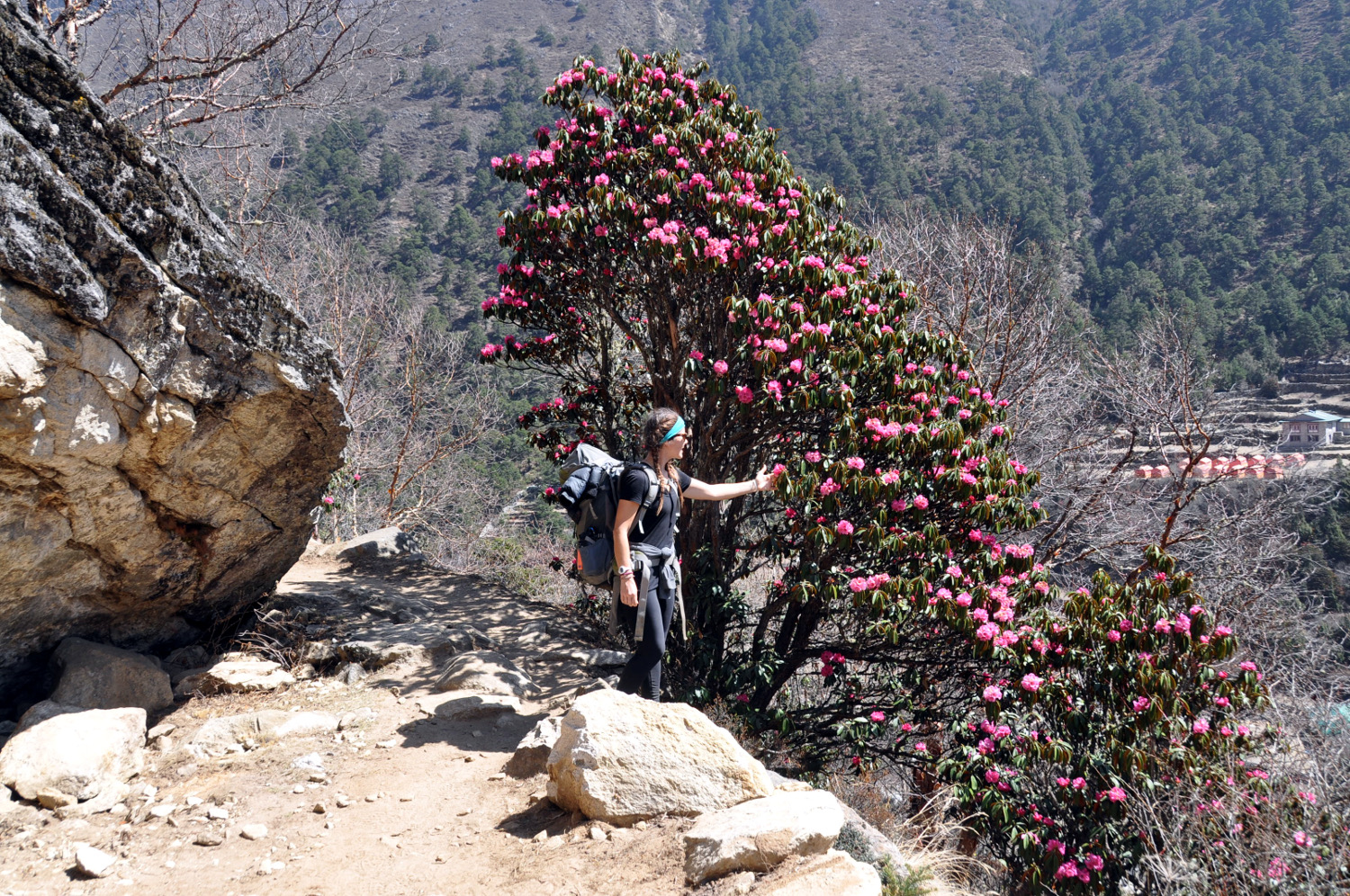



Total trekking time: 5 hours and 15 minutes + Rest time: 15-minute snack break in Mong La
Description: If you’re like us, you might start to get a little goofy as more oxygen hits your body. You’re going downhill all day except for the hour climb up from Phoete Tenga to Mong La.
The rest of the day is walking on well-groomed paths with many places to stop and rest along the way. Enjoy the beautiful greenery that surrounds the valley.
Difficulty Level: 6.5 – Going downhill is great! But the hour steep up hill is kind of a buzz kill.
Teahouse: Khumbu Lodge (Same as Days 2 & 3)
Tip: Don’t forget to stop by Himalayan Java Café next door to Khumbu Lodge and eat as many walnut brownies as you can!
Tip: Time to celebrate! Congratulate yourself with a drink at the highest Irish Bar in the world. But don’t have too many, you have a long day tomorrow.
Day 16: Namche Bazaar to Lukla
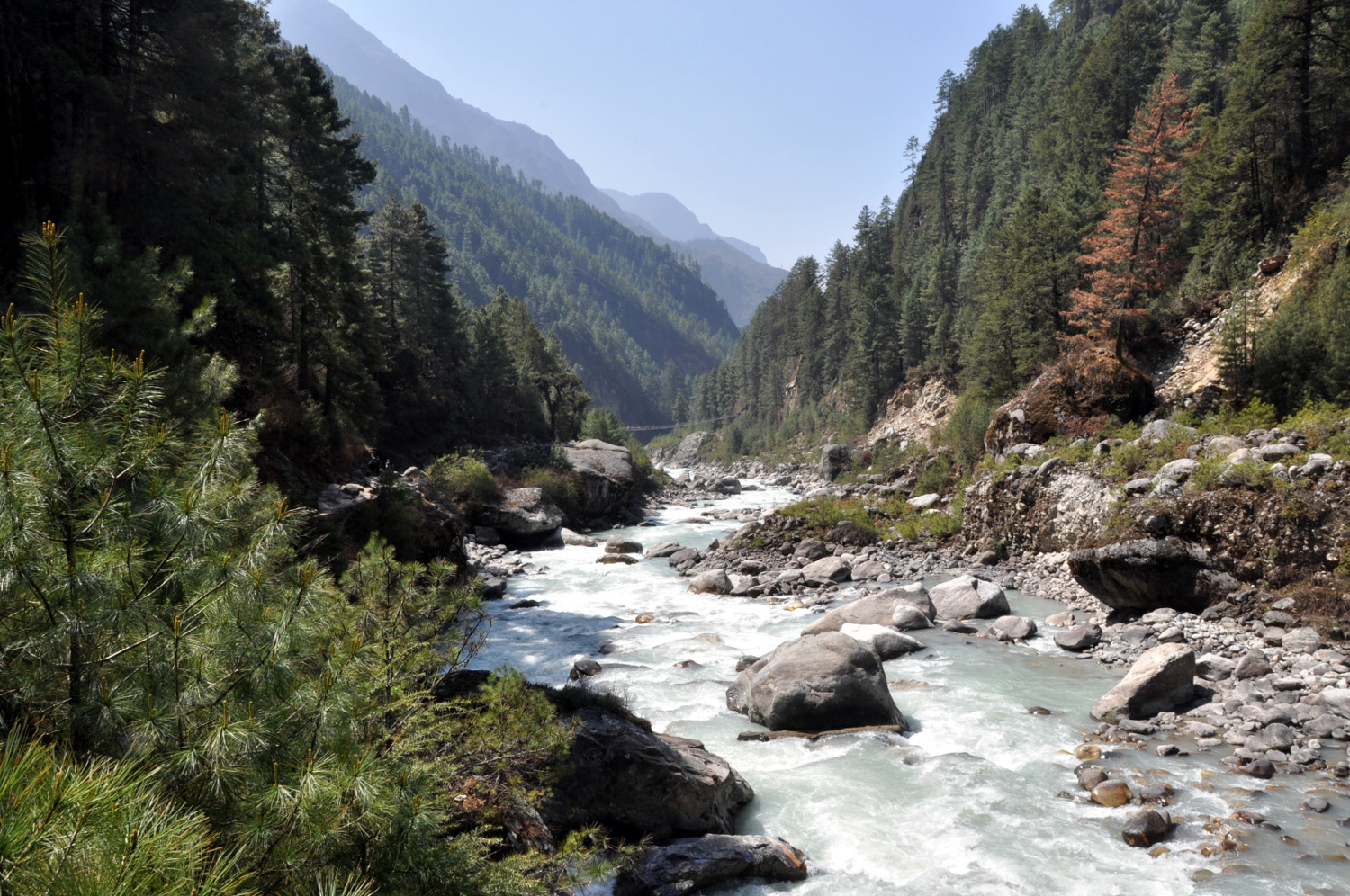



Total trekking time: 6 hours and 15 minutes + Rest Time: 45-minute lunch in Phakding
Description: Reverse your steps from Days 1 & 2 from the beginning of your trek as you head down the massive hill before Namche. Cross suspension bridges and pass through the small villages as you see other bright-eyed trekkers heading the opposite direction.
Difficulty Level: 5 – You should be feeling like an Olympic athlete as you stroll back through the small villages in the valley.
Teahouse: Sunny Garden Lodge
-
Cost: 200 rupees
-
It’s had a small room and not the best food. I also heard mice in the middle of the night. But hey, it was just our last night.
-
Recommended: No, there are plenty of other places in Lukla.
Last Day: Fly Lukla to Kathmandu
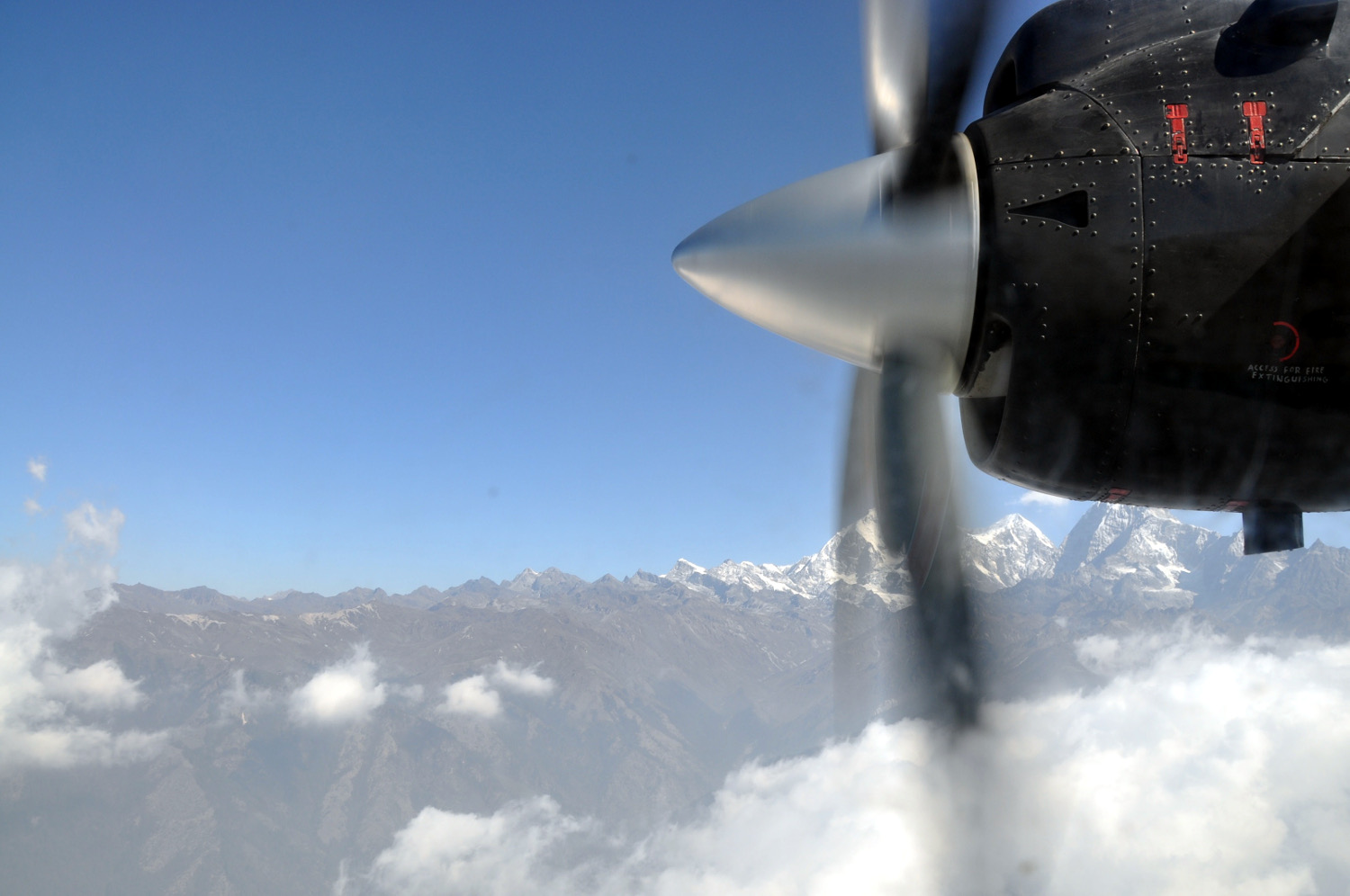



Description: Grab a quick breakfast and head to the airport. Make sure to get there early, because it gets crazy in the one room terminal. Once your plane arrives, it’s a quick turn around and you’re boarded. Say one last prayer to the Khumbu gods as you take off on what can be the scariest flight in the world.
EBC Video Diaries
Watch Part 3 of our video diary from Day 11 through 17 of our trek. It shows our trek over the challenging Cho La Pass and our final decent out of the Himalayas. We added bloopers and even a Snickers commercial we made for your enjoyment!
Are you planning a trek to Everest Base Camp? We can help!
We have TONS more resources on trekking EBC. Check out our Nepal Homepage for more resources and some of our favorite articles on Everest Base Camp below.
Save this on Pinterest for later!
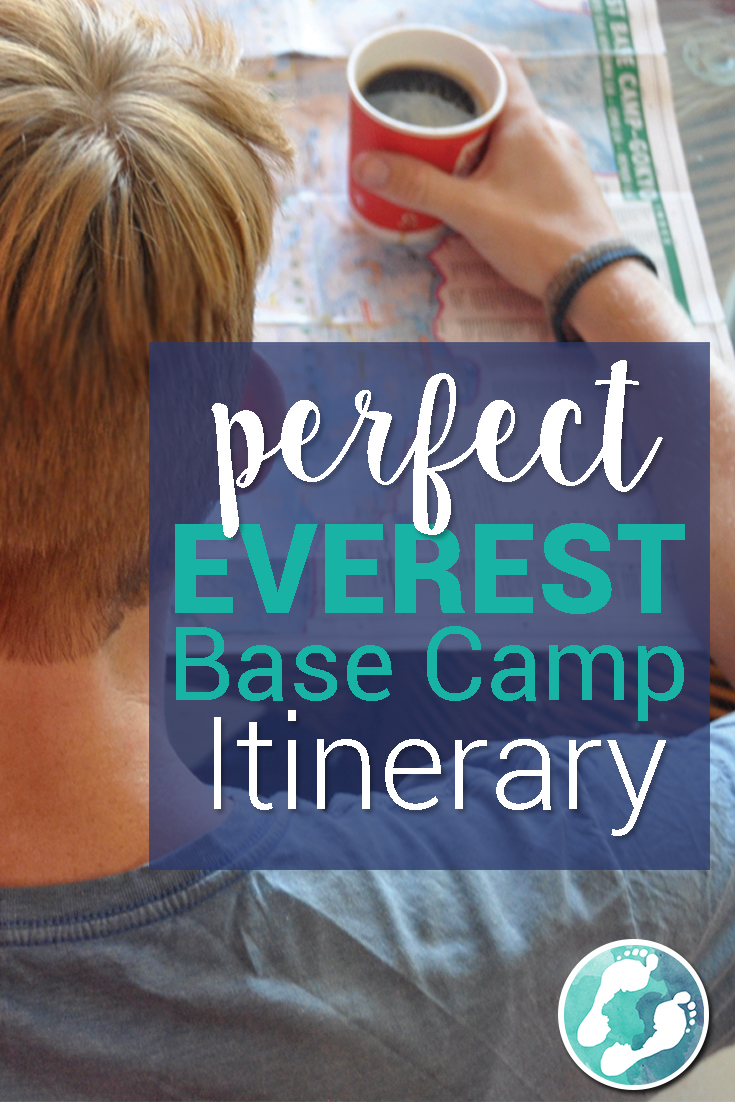



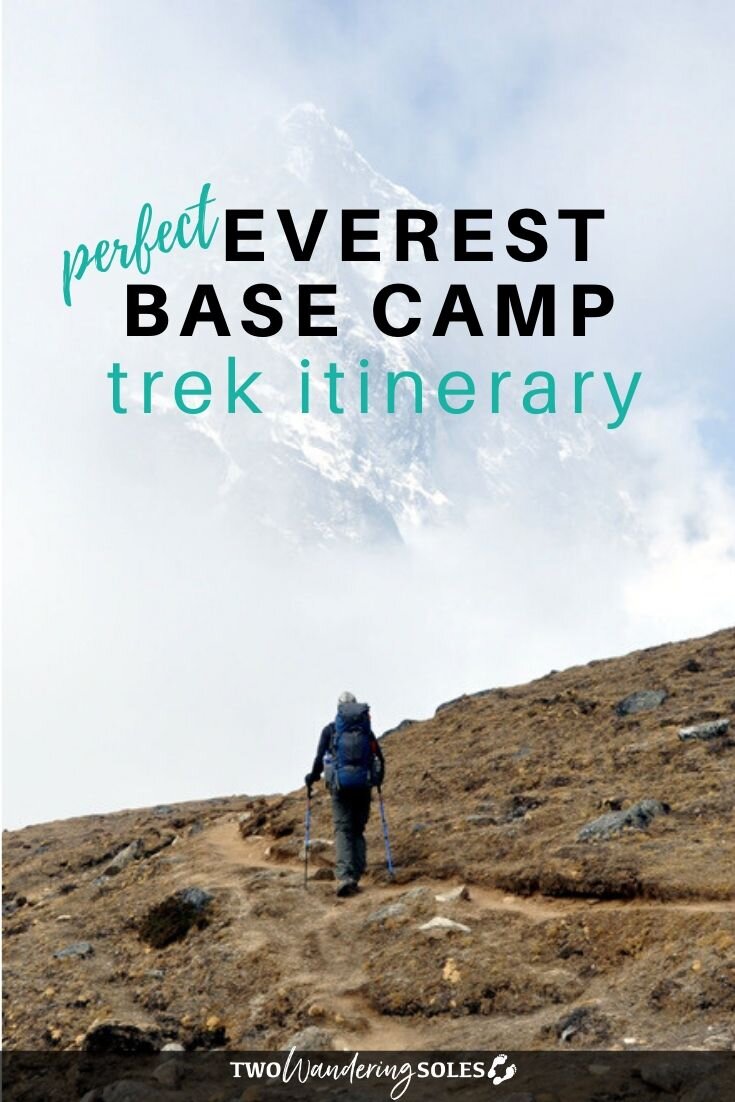



We want to hear from you!
What do you think about our itinerary? Have you trekked to Everest Base Camp or Gokyo Lakes? Do you have any additional tips? Share in the comments below.

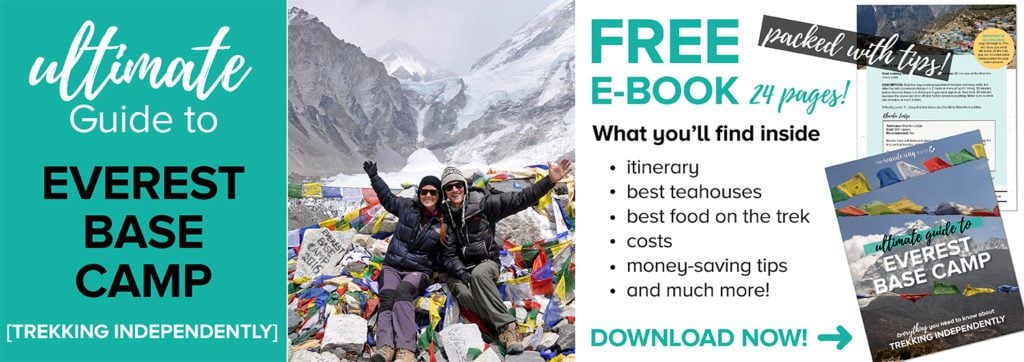


Hi! So I am in the mountains of Vietnam right now and I’ve been reading through your Everest Base Camp articles because I’ve decided since I am already in this part of the world and the flights from Hanoi to Kathmandu are not expensive I am going to do both Annapurna and Everest Base Camp alone. Here is my question and it may sound silly…. For Everest Base Camp are there road signs telling you which direction to go in for each stop? Like ya know… "This way to Monjo" "This way to Goyko" are there road signs to Everest Base Camp? and it’s the same question for Annapurna. If there are road signs to Everest Base Camp I am 1,000 percent gonna do it on my own, but if I were to have to sole rely on a map, it might make be think differently or well, I’m not THAT great with maps….. Road signs???
Hi Mykki, not a silly question at all. There are signs leaving each town pointing you in the direction of the next town/village. The trail is pretty well marked and you won’t have any issues. And if you do get turned around, you can always ask a fellow hiker or a local to point you in the right direction. Hope that helps! Have fun trekking!
Hi Folks! Great article! We’re prepping to do EBC this April. I really like the Steripen idea. Where were you getting the water to purify? Out of rivers or is there ‘tap water’ of some sort to be found? Did you actually find that you got 150 liters out of a set of lithium batteries?
Cheers- Matt and Jen
Hey Matt and Jen! We love our Steripen and it really came in handy on the EBC trek. There will be spots to fill up at tea houses every hour or two. No need to fill up from rivers. And then you just sterilize that water with the Steripen. If you get the good lithium batteries, the Steripen does work for a long time (I didn’t exactly count it out, but I would be very confident with the stats on how long it lasts). Just make sure to bring spare batteries just in case. Happy trekking!
Hi Katie and Ben,
Thanks for such a detailed guide! Me and my boyfriend will be doing EBC in September and plan to follow your guide almost exactly. When looking at travel insurance with World Nomads it states that "You must be with a professional, qualified and licensed guide, instructor or operator". Was this the case when you purchased insurance via World Nomads?
Hi Louise, I just checked our World Nomads insurance policy and it doesn’t say anything about needing to be with a professional or guide. Have you contacted World Nomads about this question?
This seems strange that you would come across this, because World Nomads gives out these policies for any type of traveler (whether you are trekking EBC or not) and when you travel you will not always be with a guide. Let me know what World Nomads says 🙂
Hi Ben & Katie,
Your Journey is really inspiring me. I’m planning to do EBC trek on coming October. May I follow the same Itinerary for October or should I have to change the itinerary. And also I’m totally new to mountain trekking. Can you please tell me about what dress have to wear during day & night time.
Thank you
Hey Boobalakannan, it’s the same route to follow whether it’s in the spring or fall. We have a whole series of articles on how to trek in EBC and what to pack on our Nepal Page.
Let us know if you have any more questions! Happy planning!
Ben & Katie,
My daughter and I are gearing up for EBC/Gokyo and was wondering a couple of things. Did you have to sanitize coffee at the tea houses or does general processing kill the parasites? Did you acquire all snacks in Kathmandu or purchase along the way? Also, did you use diamox or just trust your acclimatization schedule? We’ve trekked high country in the Rockies, climbed Rainier, but this will be our first go at sustained altitude and I’m afraid of my old man disease. BTW, your blog is very well done and informative; I see so much of my daughter in your lives….consider that envy.
Hey Gary, thanks so much for the compliment 🙂
Here are the answers to your questions:
1) For coffee/tea at the teahouses, they provide you with a thermos of hot water, which is safe to drink. Any water that hasn’t been boiled needs to be sterilized (we recommend the Steripen).
2) We had been traveling for 6 months prior to our trek, so we bought our snacks in Kathmandu. There are a few stores in the Thamel neighborhood that have a decent selection of trekking snacks, but if you are coming from home, we’d definitely recommend purchasing your snacks prior to your trip. You’ll have a way bigger selection! (Plus, we weren’t easily able to find things like protein bars, beef jerky, or a good selection of trail mix and dried fruit in Kathmandu.)
3) We took Diamox (purchased in Thamel). We’ve done high altitude hiking before, but never that high for such a long period of time. And I’ve gotta say it affected us much more than any other hiking we’ve done. We don’t like taking medicine very much, but are happy we did in this case.
Best of luck. We’d love to hear about your experience! What a special thing to share with your daughter.
Hello Katie and Ben!
Just discovered all of this wonderful info, thank you so much! Planning a trek for this fall, and although the route that you took looks perfect, not sure we will have the time to do the whole loop. That said, we may need to choose between out and back to EBC or out and back to Gokyo Lakes. I’ve been reading that the EBC trek can become quite crowded and even a bit ‘touristy’, where the Gokyo trek is a bit more remote. Gokyo offers glimpses of Everset, but of course doesn’t get you to base camp. With the ‘touristy’ thing in mind, (and us not interested in big crowds) wondering what your advice might be. If you had to choose one of the out and back treks, which one would you do, having experienced what you did? We have 3 weeks total, that’s with travel from the states, so I’m guessing a total of 12-14 days on the trail. Any thoughts very much appreciated!
Thanks and cheers
-Kelly
Hi Katie and Ben,
My boyfriend and I are planning a 6 month trip around south east Asia next year starting with the base camp trek in April. Your blog has been an absolute dream with regards to our planning, we love it and it’s been so useful.
I wanted to ask you how much money you think is sensible to have on us for the trek? Also i’ve read that it is not safe to do the part of the trek to base camp itself without a guide as it is really easy to get lost. Did you find this to be a problem or do you think it is reasonable to attempt it without a guide?
Thank you in advance 🙂
Jo
Hi Joanne! That’s so exciting your going to go to EBC! If you check out our EBC Budget article it describes how much you should bring on the trek.
To be honest, we did not have a problem finding any of the trails along the way to EBC. The paths are well defined and there are always a handful of people within site so you can follow in their direction. If you’re fully prepared and know how to acclimate properly then you will be fine without a guide, we were 🙂
yes we have done many times trek to Gokyo, Chola pass, Renjola pass, Ebc base camp.Island peak. The trekking destinations are very popular and highly demanded Treks in Nepal
Glad to hear you’re getting out on the trail.
Hi Katie and Ben,
We are heading to Nepal next Saturday and plan to follow your route almost exactly as will plan to trek independently. Your blog is excellent and we’ve found each page really helpful with our preparation! We haven’t booked our Lukla flights yet as we figured it would be easier to do this in Kathmandu after doing lots of research. I just wondered how you found this process and if you found getting a seat on the planes difficult without a guide or porter-guide to get you to the front of the que? We have done a few long distance treks before and a relatively experienced, but I’ve read that the Cho La Pass can be dangerous. I just wondered how you found it and if you would recommend getting a guide for this section (if this is possible)?
Any tips/advice would be greatly appreciated.
Sally & Dave
Hi Sally & Dave, I’m so glad you’ve found our site helpful! Great questions, we’ll do our best to answer.
1) Yes, waiting until Kathmandu should be just fine (at least it was in our experience!). You might want to plan to have a couple extra days just in case the exact day you want isn’t available, but we got our first choice, so you might be lucky, too. Also, just something to keep in mind – if the weather isn’t good the flights won’t go as scheduled, so you’ll have to go later than planned (everyone – even people who had their flight reserved far in advance). And you don’t really get seat number assignments. It’s a small plane and you just kind of walk on first come first serve. It doesn’t matter if you had a guide or not (at least that was the case on our plane).
2) We were a little nervous for Cho La Pass too, but it turned out to be fine. We didn’t have any special equipment and most people we saw didn’t (except for the big organized groups). I’m sure you could get a guide for that leg if you really sought it out, but I don’t think it’s super necessary unless you’re feeling really apprehensive. When you start the trek, you’ll kind of run into other people doing the same thing (there’s only one path, after all haha!), so follow them, stick together and use each other for encouragement. There’s a great place to stop after you cross the pass where lots of people gather and kind of encourage each other – it’s fun! And after the pass, you’ll want to be careful scrambling down the rocks, but if you take it slowly you should be fine. Next, you’ll cross a glacier and when you reach Gokyo after a long day, you’ll be so happy!
I hope these ramblings help! Have SO much fun and let us know how it goes. We’d love to hear how you like it.
best & detailed. i’m planning to trek lukla – tengboche with my wife & 8 years old daughter. my concern is – is this trek route is suitable for my daughter.
where should i book the guide – at katmandu or at lukla.
thanks!
cheers
sampen
Hey Sampen! Sounds like a fun family trip you have planned. That’s a tough question – it truly depends on your daughter. I’m assuming you’ve brought her trekking before if you’re planning to go to Nepal with her, so if she has done some big hikes she may be just fine. We did see a handful of children along the trek (mostly at the lower towns), but definitely not a ton. If you are confident in your daughter’s stamina and trekking abilities I would say go for it! The only thing is that everyone (adults and super fit people included!) reacts to the altitude differently. So I’d be sure to pay attention to how your daughter is handling the change in altitude and build in some extra days so you can take it slowly. Best of luck. Let us know how it goes.
The cost per tea house you have mentioned in surprising very low. What time of the year did you do EBC?
We did the EBC in April of 2016. Yes, tea house prices are low, but typically you must eat at their adjoining restaurants if you stay there. This is how the tea house owners really make their money. Some are even free to sleep in, but you must eat there. Your food bill plus the charge for your room is the price you pay for a bed, but still isn’t bad 🙂
Hey Katie, great post! Are your prices quoted including the food you purchased or just the bed cost? There are so many "averages" on the interwebs…can you give us an example of the breakfast, lunch, and dinner costs you two experienced? Thanks!
Hey Daniel, we’re happy to clarify! The meals were on average $3-5 USD per person (roughly 300 – 500 rupees). You can definitely spend more or less per meal, and the prices do tend to increase as you get higher in elevation. Considering that many ingredients need to be trekked in, we thought the prices were very reasonable.
We actually made an entire post about how much our trek cost us and broke down the expenses by accommodation, food, etc. I think the article will give you a much better idea
(Just as a side note: We trekked independently – no porter or guide service – so our costs will be cheaper than if you go through an organized group or hire a porter.)
A Great Post!
Thanks so much!
Awesome article with day to day itinerary with description and pictures of Mount Everest trekking area Khumbu
Thank you so much, Shankar. That’s very kind of you to say 🙂
I love your guys’ blog and have read it multiple times! We are doing this trek in March and one of the biggest questions I have is about the flight to Lukla – did you book your flights before you got there? Who did you book your flights through? I want to book our tickets before but unsure of who to do it through. Thanks!!
Hey, I’m so happy to connect 🙂 That is a great question, and certainly one we were a bit concerned about. There’s not a ton of info on it out there. But there’s good news – you really don’t need to worry about this for a while! While you can certainly purchase your flight in advance, it’s not always necessary. If you are going to be really pressed for time and will only have a day in Kathmandu, I’d recommend getting your flight ahead of time. You won’t be able to purchase it like a regular flight on Kayak or Skyscanner. Instead, you’ll have to contact a tour company in Kathmandu via email and pay them using PayPal. It usually costs a bit more to arrange this in advance with PayPal fees, etc. (It’s not super significant – maybe around $30.)
Remember when you buy a flight to Lukla, it is really smart to have a few days of wiggle room since flights only leave when weather permits. We were super lucky and only got delayed a couple hours, but we met a guy on our flight who had come to the airport 3 days in a row because they weren’t able to fly due to poor conditions.
We bought our flights through an agency in the Thamel neighborhood (can’t think of the name at the moment). We walked into the shop 2 days before we wanted to leave and bought them on the spot. It is right across the street from the biggest supermarket in Thamel, so it was very convenient when we were stocking up on snacks to bring with 🙂 I think prices are relatively similar all around town (the flight to Lukla stays pretty much the same price at all times), and most of the agencies are the same – we chose this one mainly because of convenience and also because our friend was picking up his there as well.
The great thing about the flights to and from Lukla is that your return date is flexible. If it takes you longer to do the trek, you can call the agency and they’ll switch your date. And vice versa – if you finish early, they can get you on an earlier flight.
I hope this helps. Please don’t hesitate to ask if you have other questions when planning. I know it can be a bit overwhelming, but it is SO worth it!
Thank you so much! I connected with an agent that was recommended on a couple blogs so hopefully that all pans out! I’ll let you know how it works out! Your blog is super helpful by the way!
I’m glad you got it sorted out, Courtney! Let us know if you like the agent and we can recommend them to others who ask 🙂 Have the BEST time! We’d love to hear about your experience. (And thanks for the kind words!)
Love your blogs on EBC – the description and pictures are awesome. My husband and I are planning to do the EBC trek in Mei 2017 (with guide and porter) ….. we are reaching 50’s. We will most likely walk like a snail but we hope our journey will be as interesting as yours…..and hope the weather will be kind to us.
Thanks for sharing your experience.
Azian
Malaysia
Hi Azian, You’ll love the EBC trek! We would love to go back. Trust me, we walked like snails the whole way, but I think that is best 🙂 The weather in May should be good. Keep us posted on how it goes! Trek on!
Hi Katie…nice to meet you
Im Raj from Malaysia,
I’m on a quest to EBC in Nov2017 accompanied with my friend.. we are going solo, without a porter or a guide..which i find the Gokyo circuit a little tricky and a little hesitant to do it without a guide as i do not know what to expect, and we could get lost in the dangerously unforgiving terrain..
So i was scouring the web for ton of info as im already planning meticulously.. yet i was still pondering some things as i could not get much info of incorporating the Gokyo circuit into my EBC trek until i came across your video in Youtube which eventually led me to your blog.
By far your blog is the most comprehensive one i’ve come across, and im very glad i spotted it. Now i know how to get there and what to expect. One of my concerns are the frigid temperatures and snowfall as im from the tropical southeast Asia at sea level, i haven’t really experienced weather below 18’C. Thank you so much for sharing your wonderful experience to fellow first-time trekkers like us. I would be extremely glad if you could share any other valuable advise for me. Drop me a msg at ryanraj_7@yahoo.com. Thanks a million. Cheers!!